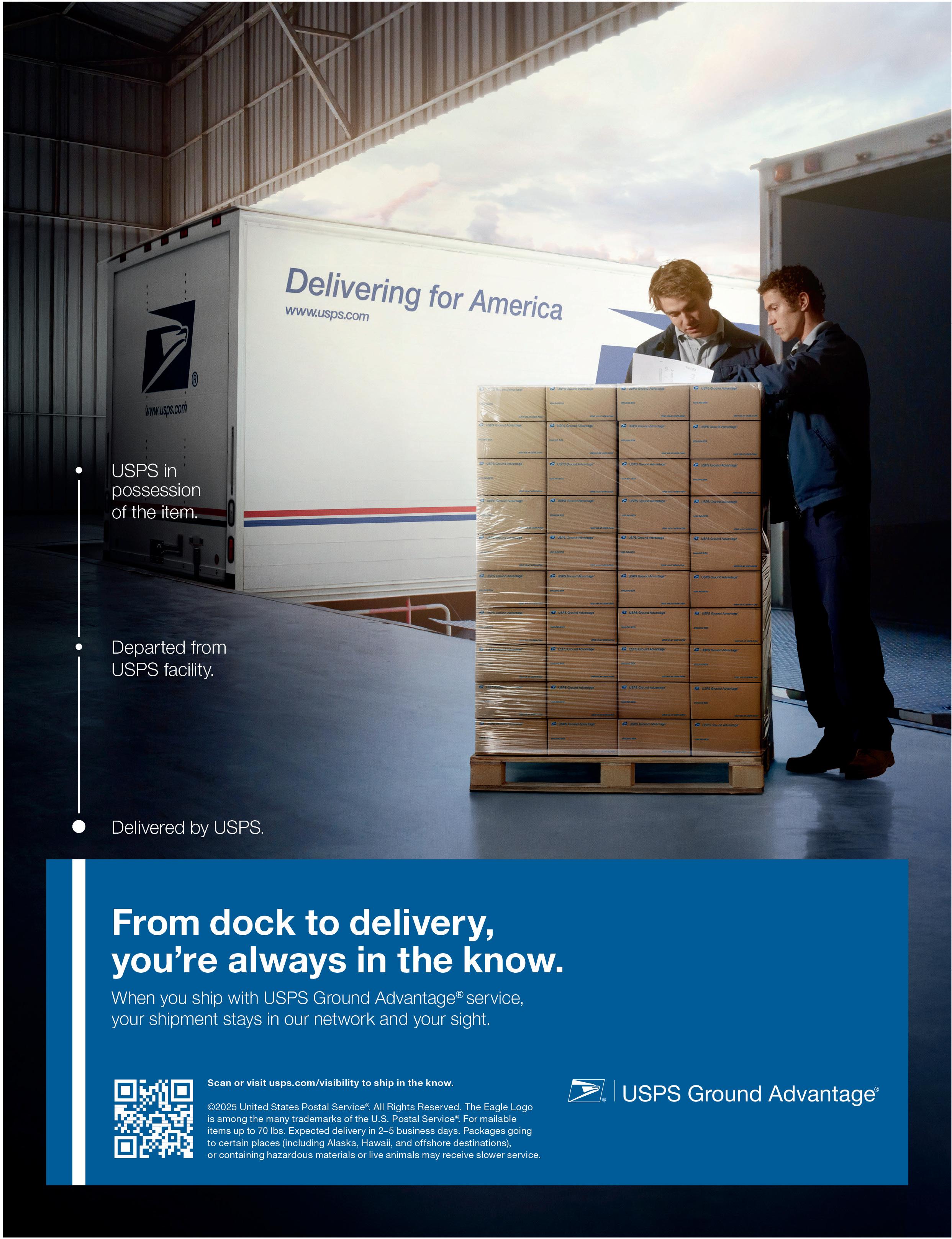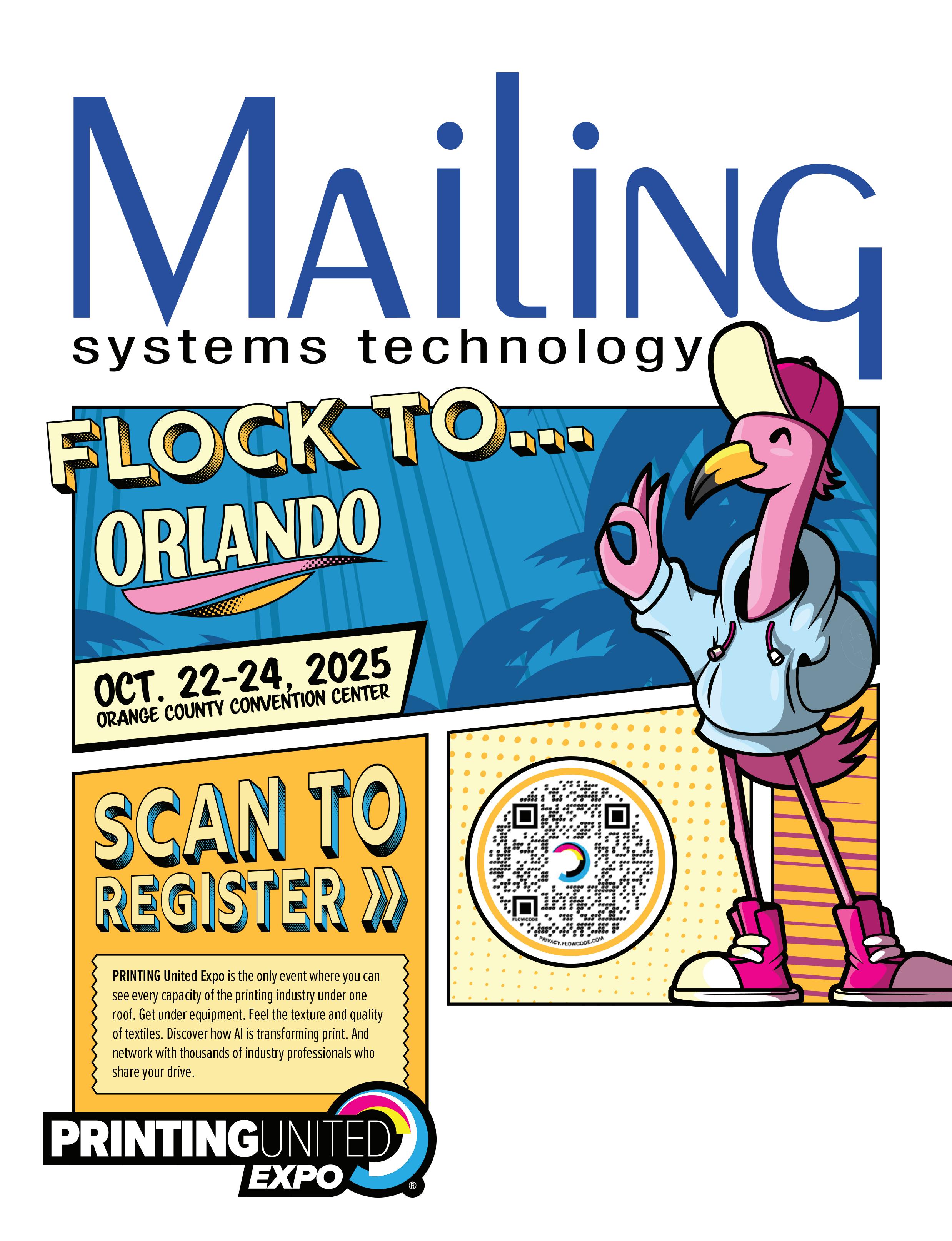
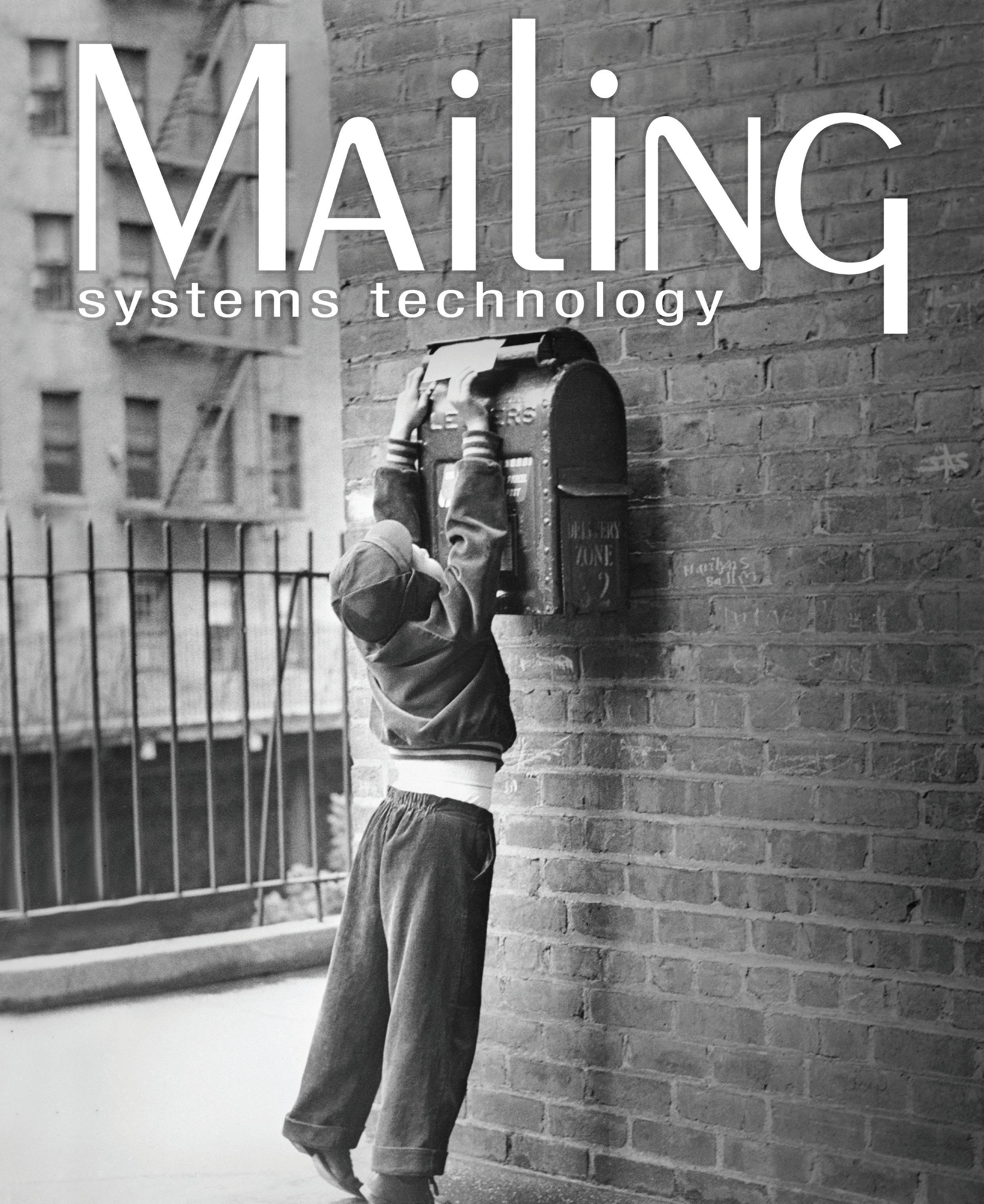
SUPERCHARGE YOUR ADDRESS DATA WITH FIVE CRITICAL STEPS. PAGE 16
SIX REASONS YOUR MAIL OPERATION NEEDS AN AI POLICY. PAGE 18 WHAT DOES THE RECENT USPS RATE INCREASE MEAN FOR YOUR BUDGET? PAGE 26




SUPERCHARGE YOUR ADDRESS DATA WITH FIVE CRITICAL STEPS. PAGE 16
SIX REASONS YOUR MAIL OPERATION NEEDS AN AI POLICY. PAGE 18 WHAT DOES THE RECENT USPS RATE INCREASE MEAN FOR YOUR BUDGET? PAGE 26

Starting July 13, 2025, the USPS® will increase many rates for both mailing and shipping products. These changes are part of an ongoing trend across the industry — UPS, FedEx, and other major carriers have also raised their rates and surcharges throughout the year. This leaves businesses trying to navigate a more complex and costly shipping and mailing environment. Pitney Bowes can help your business manage costs, simplify processes and give you control over mailing and shipping.
Certified Mail remains a critical service for businesses needing proof of delivery, but it continues to be a tedious manual process that keeps costing more. Pitney Bowes software simplifies the entire Certified Mail® process. Our software enables you to process, send, and track Certified Mail online, eliminating manual forms and lost green card receipts. By switching from the traditional green card return receipt to an electronic return receipt, businesses can save up to $1.58 per mail piece. Managing signatures and delivery confirmations is easier, faster, and more cost-effective.
Pitney Bowes shipping software automatically applies discounts on USPS services like Priority Mail®, Ground Advantage™, and Priority Mail Express®. This means your business gets access to discounted rates with or without an NSA. Our multicarrier platform gives you the flexibility to compare rates and delivery times, so you can easily choose the best rate for you. You can then track every parcel from drop-off to final delivery — all in one place. The savings and convenience make it easier to ship smarter with the USPS.
In today’s landscape, relying on a single carrier is no longer sustainable. That’s why Pitney Bowes multicarrier software provides access to discounted UPS® and FedEx® rates. Businesses can switch shipping volume to these major carriers

without the hassle of setting up new account numbers. Our shipping software allows you to print labels, compare rates across carriers, and track packages with ease — giving you the power to choose the best carrier for every shipment.
As shipping and mailing costs continue to rise across the board, businesses must become more strategic in their approach. Pitney Bowes is here to help. With solutions that deliver savings on Certified Mail, USPS, UPS, and FedEx, plus powerful tools to simplify the complexities of multicarrier management, we make it easier to take control of your shipping and mailing like never before.

Scan here to get in touch or visit us at pitneybowes.com/ software to learn more.
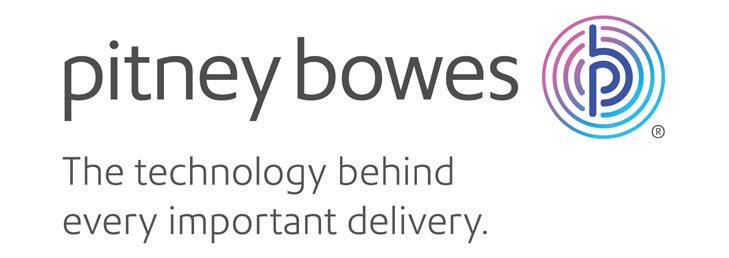
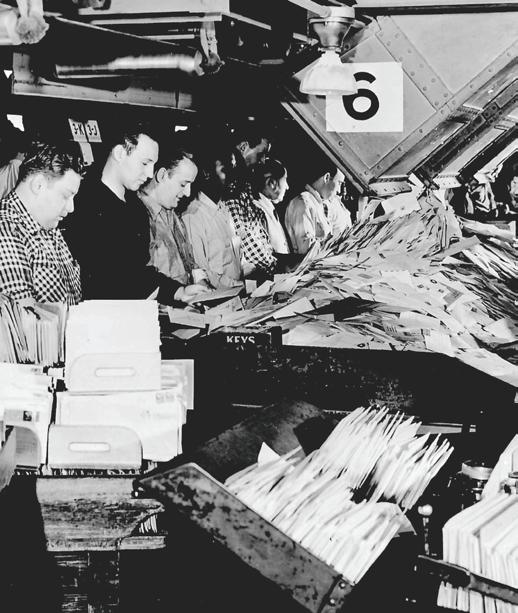



VOLUME 38, ISSUE 4
MAGAZINE STAFF
President Chad Griepentrog
Publisher Ken Waddell
Editor Amanda Armendariz
amanda.c@rbpub.com
Contributing Writers
Greg Brown, Brian Cook, Wes Friesen, Karen Kimerer, Adam Lewenberg, Mike Porter, Leo Raymond, Bob Rosser, Mike Sanders, Kathleen J. Siviter
Audience Development Manager
Rachel Chapman rachel@rbpub.com
Advertising Ken Waddell
608.235.2212 ken.w@rbpub.com
Design Kelli Cooke
MadMen3 PO Box 259098 Madison WI 53725-9098
Tel: 608.241.8777
Fax: 608.241.8666
Email: customerservice@rbpub.com
SUBSCIRBE
Subscribe online at MailingSystemsTechnology.com.
Subscriptions are free to qualified recipients: $20 per year to all others in the United States.
Subscription rate for Canada or Mexico is $40 per year, and for elsewhere outside of the United States is $45. Back issue rate is $5.
SEND SUBSCRIPTIONS TO:
Mailing Systems Technology, PO Box 259098, Madison WI 53725-9098
Call 608.241.8777
Fax 608.241.8666
E-mail rachel@rbpub.com
Online at MailingSystemsTechnology.com.
REPRINTS: For high quality reprints, please contact Chad Griepentrog, 608-241-8777, chad.g@rbpub.com
All material in this magazine is copyrighted ©2025 by MadMen3 All rights reserved. Nothing may be reproduced in whole or in part without written permission from the publisher. Any correspondence sent to Mailing Systems Technology, MadMen3 or its staff becomes property of MadMen3.
The articles in this magazine represent the views of the authors and not those of MadMen3 or Mailing Systems Technology. MadMen3 and/or Mailing Systems Technology expressly disclaim any liability for the products or services sold or otherwise endorsed by advertisers or authors included in this magazine.
MAILING SYSTEMS TECHNOLOGY
(ISSN 1088-2677) [Volume 38 Issue 4] is published six times per year (January/February, March/April, May/June, July/August, September/October, November/December) by MadMen3, PO Box 259098 Madison WI 53725-9098, 608-241-8777. Periodical postage paid at Madison WI and additional offices.
POSTMASTER
Send address changes to:
Mailing Systems Technology
708 W Mohawk Trail Deforest, WI 53532
BY AMANDA ARMENDARIZ
This special issue of Mailing Systems Technology, highlighting 250 years of the United States Postal Service as a cornerstone of the American communication system, has been an especially enjoyable one to put together. Being so entwined with our nation’s history from the beginning means that the USPS holds a special place in many Americans’ hearts — even if we do experience frustration from time to time with some aspects of its operation. It’s utterly amazing to think of how far we have come from the days of horse-drawn delivery to today’s intricate network of mail delivery channels. The USPS has certainly changed over the years, but one thing that has stayed the same is the organization’s commitment to ensuring that mail carriers reach every address, every day.
Of course, not everything to do with the USPS is a bright spot. On July 13, we saw the seventh rate increase in four years take place, and prices are going up
substantially (more than the pace of inflation). Mailers are caught in a balancing act of wanting to keep their mail pieces in the mail stream (especially since we know that mail works and is more trustworthy than its digital counterpart) but needing to rein in their postage spend in the wake of these increases. It’s certainly a balancing act, given that multiple rate increases per year have become the new norm, requiring mailers to look for creative ways to save money on their communication pieces.
While we can’t know for sure what the next 250 years will bring (or even the next 25), we can work to ensure that policies are put into place to ensure the USPS’s survival for decades to come. Americans deserve nothing less.
As always, thanks for reading Mailing Systems Technology.

BY WES FRIESEN
In today’s fast-paced and ever-changing world, being proactive is more important than ever. Proactivity is the ability to anticipate and prepare for future challenges and opportunities, rather than merely reacting to events as they occur (i.e., being proactive versus reactive). Being proactive isn’t merely just being prepared for the unexpected — it’s about actively shaping the future rather than merely reacting to circumstances as they unfold. Management guru Peter Drucker spoke to this when he said, “The best way to predict the future is to create it.”
There are benefits to us and our team members when we adopt and apply the proactive mindset, including:
Increased Productivity: By planning ahead and prioritizing tasks, we can manage our time more effectively and do more in less time.
Greater Personal Fulfillment: Taking more control of our life and making conscious choices leads to a greater sense of satisfaction and fulfillment.
Better Stress Management: When we are proactive, we are less likely to experience stress because we anticipate challenges and plan ahead. By staying organized and preparing for potential problems, we minimize the risk of last-minute scrambling and panic.
Personal Growth and Development: Growth and development can occur when we and our team members proactively take classes; read books and trade journals; attend seminars, webinars, and conferences; take part in training programs; earn professional certifications;
and engage in mentoring relationships. (Note: I suggest considering keeping an annual development plan for yourself and all your team members).
Greater Career Success: The growth and development activities just described will help us and our people be more successful in current roles and prepare for potential roles of interest. And showing proactivity by taking the initiative and going beyond the job description will be noticed and eventually rewarded.
Stronger Relationships: Proactive minded people tend to have stronger relationships due to addressing issues before they escalate, communicating openly, and looking for ways to help and add value to others. Also, proactively networking and leaving our comfort zones to meet new people helps us broaden our networks and sometimes leads to making life-long friendships.
1. Embrace a Proactive Mindset. Michael Hyatt spoke to this when he said, “You have a choice in life. You can either live on purpose, according to a plan you’ve set. Or you can live by accident, reacting to the demands of others. The first approach is proactive; the second reactive.” John Maxwell expressed similar sentiments when he said, “I believe that everyone chooses how to approach life. If you’re proactive, you focus on preparing. If you’re reactive, you end up focusing on repairing.” For example, as a long-time adjunct university professor of mostly adult learners, I greatly respect
people that proactively decide to finish their undergraduate or graduate degrees. They do this even though they have fulltime jobs and busy personal lives.
2. Set Clear Goals. We can start by defining our personal and team long-term and short-term goals. As Stephen Covey said, “Begin with the end in mind.” We can break goals down into actionable steps with timelines for achieving them. This helps provide direction and ensures we are actively working towards what we want, rather than passively going with the flow. And as we and our teams make progress towards reaching our goals, we can take time out to celebrate successes, which will inspire and lead to more success (i.e., “success breeds success”).
3. Plan and Look Ahead. Proactive individuals don’t wait until the last minute to tackle tasks or make decisions. Instead, we can anticipate upcoming potential obstacles, needed tasks and decisions, and plan accordingly. This could mean creating a project timeline, setting deadlines, or preparing for meetings in advance. It can also include looking at our staffing future needs, such as planning for potential retirements, and developing and training our team members to thrive with recent technology (including learning and applying relevant AI technologies).
4. Anticipate Challenges and Problems. We can think about potential obstacles and problems we may face and develop strategies to overcome before they happen (i.e., thinking upstream before the fact versus downstream after the fact). We can take to heart Ben Franklin’s advice that “An ounce of prevention is worth a pound of cure.” This can include contingency planning for unexpected equipment downtime, severe weather, or staff absences.
5. Take Responsibility. Instead of blaming circumstances or other people for setbacks, we can take responsibility for our actions and the outcomes. Playing the “blame game” or falling into the victim mentality doesn’t make things better. Instead, we can take control of situations and become empowered to influence the outcomes. I agree with Stephen Covey when he wrote, “Proactive people are agents of change and choose not to be victims, to be reactive, or to blame others.”
6. Take Initiative and Fight Procrastination. Being proactive means taking initiative and action and not waiting for others to tell us what to do. We can look for opportunities to have influence and add value to people both at work and in our personal lives. As leadership expert John Maxwell said, “Don’t wait for something to happen, MAKE it happen!”
We can also fight procrastination (I think we all battle this at times. I know I do).
Benjamin Franklin advised, “Never leave till tomorrow, which you can do today.” Here is a technique that I learned from a mentor years ago: tackle and complete a unpleasant or challenging task first, then reward yourself in some manner (e.g. take a break and walk around, have a quick snack, or peek at a favorite social media site). A simple mantra I tell myself based on this concept is “work before pleasure.”
7. Stay Positive and Solution Oriented. We need to be aware of and fight against negative thinking. I agree with Willie Nelson’s quote, “Once you replace negative thoughts with positive ones, you’ll start having positive results.” Henry
Ford wisely said, “Whether you think you can or think you can’t, either way, you are right!” There is power when we keep a positive, solution-oriented attitude when problems arise with the mindset of overcoming them. Instead of dwelling on issues, we can fix them and move forward. When we do this consistently we build confidence in ourselves and within our teams.
Be Organized and Prioritize. We can find ways that work for us to be organized and prioritize how we spend our time. A practical tool that people have used to be more organized and proactive is to use to-do lists. I, and many others, have found that a weekly to-do list is a good starting place and then have a short daily to-do list prepared for the day ahead. It’s important to identify and prioritize the most important tasks so we don’t get bogged down with those tasks that can consume our time but add limited long-term value. I appreciate Stephen Covey’s Quadrant 2 emphasis to intentionally plan and make time for items that are “Important, Not Urgent.”
This includes prioritizing things like building relationships; taking care of our physical, mental, emotional, and spiritual health; and planning for the future.
Concluding thoughts: Having a proactive mindset is powerful and can lead to benefits for ourselves and our teams. We need to build upon this mindset by taking action. Let me close with these two quotes. Bruce Lee advised, “Knowing is not enough. We must apply. Willing is not enough. We must do.” Pablo Picasso said, “Action is the foundational key to all success.” Go for it! You and your teams will be glad you did.
Wes Friesen (MBA, EMCM, CMDSM, MCOM, MDC, OSPC, CCE, CBF, CBA, ICP, CMA, CFM, CM, APP, PHR, CTP) is a proven leader and developer of high-performing teams and has extensive experience in both the corporate and non-profit worlds. His book, Your Team Can Soar!, has 42 valuable lessons that will inspire you and give you practical pointers to help you — and your team — soar to new heights of performance. Wes can be contacted at wesmfriesen@gmail.com or at 971.806.0812.
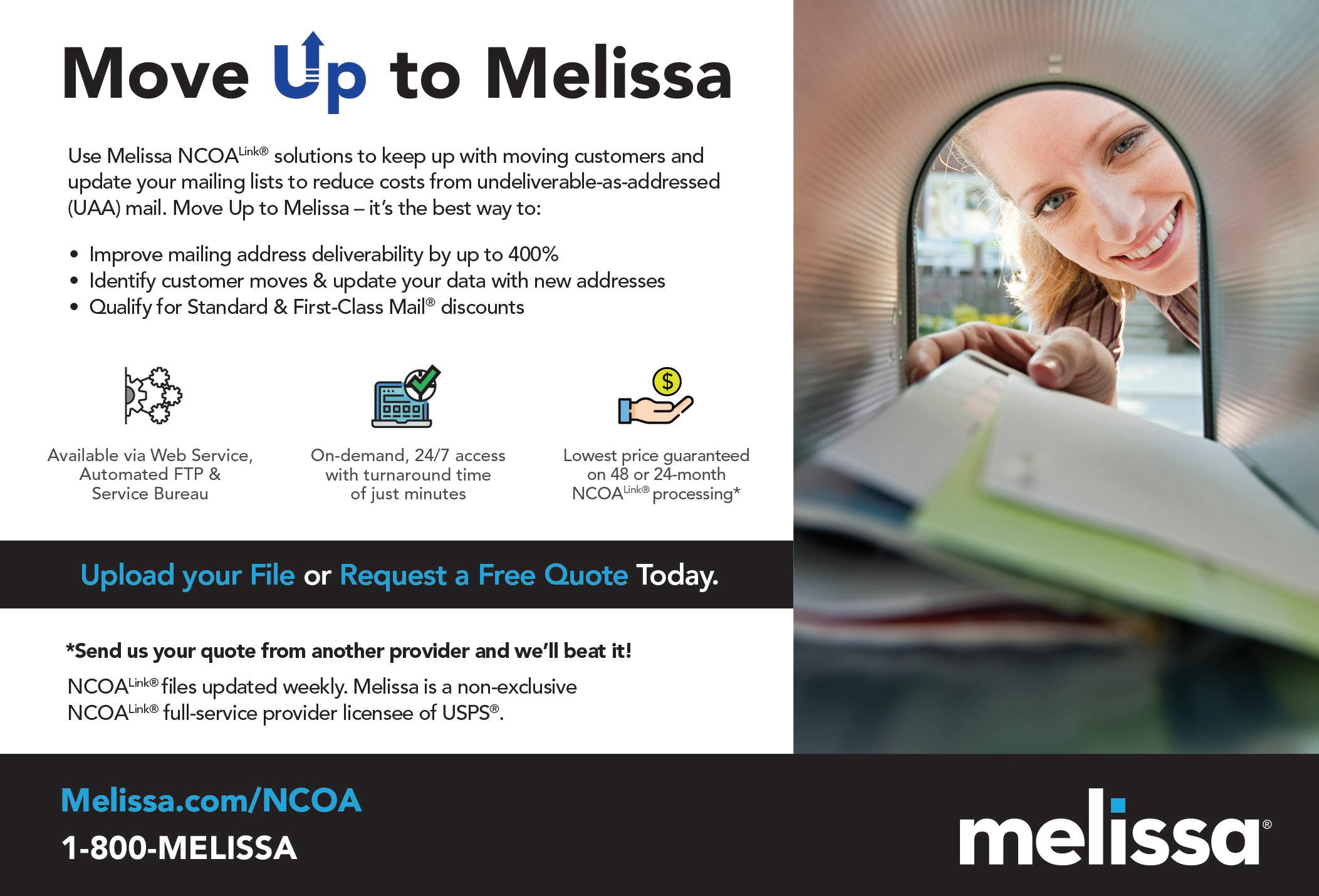
BY KAREN KIMERER
Today’s marketers face constant pressure to deliver results. In a world where consumers are inundated with messages, simply having something to say is not enough. What truly sets you apart is aligning your message with what your audience cares about.
For print and mail service providers, the success of a direct mail campaign is often more dependent on the quality of the mailing list than it is on the design or offer itself. Unfortunately, many brand owners invest heavily in high-quality printing and design while neglecting the importance of a strong data strategy. Relying on generic lists, poor segmentation, or “spray and pray” tactics can lead to wasted resources and missed opportunities for impact.
This is where the effective combination of data and inkjet technology becomes crucial. Think of your mailing list as the engine behind every campaign, with segmentation serving as the precision tuning that enables inkjet technology to achieve its full potential. This makes it possible to deliver highly relevant and impactful messages directly to your audience. Without intelligent segmentation, even the best printing technologies will not yield optimal results. This article explores effective segmentation models and discusses how the flexibility of inkjet technology facilitates versioning, personalization, and improved customer engagement.
For years, demographics have served as the default strategy for segmentation. They are easy to obtain and simple to analyze. However, this approach assumes that individuals within the same age range, income bracket, or ZIP Code always behave in similar ways. This is an oversight that can lead to missed opportunities, wasted spending, and a significant reduction in potential return on investment (ROI). Today’s consumers expect personalization. They want brands to understand their unique needs, anticipate their preferences, and communicate directly with them about their interests. While demographic data still plays a role, it should only be considered as a starting point.
The most effective campaigns are built on deeper insights derived from consumer behaviors, preferences, and real-world interactions. To fully leverage the power of segmentation, print providers and their clients must look beyond traditional marketing based solely on age and location. In recent research from Keypoint Intelligence, consumers were surveyed about their experiences with direct mail marketing and the types of personalization they have noticed in their mailboxes. The figure below illustrates various segmentation methods and their effectiveness in reaching target audiences. Notably, the data shows that personalization based on occasions and
milestones — such as birthdays and anniversaries — in direct mail is noticed half as often as content that aligns more closely with the recipient’s specific interests (21% vs. 42%).
Beyond the Basics: Activating Your Data for Maximum Impact
It’s time to move past generic outreach and truly activate your data to create campaigns that resonate and drive action. Forget simply sorting by age or location; the real power lies in understanding your audience on a deeper level. Here are some segmentation strategies you can leverage to unlock unparalleled relevance and ROI:
Prospect Interests: Don’t just guess what your customers care about; know it! Integrate their digital footprints, email clicks, website visits, and downloads to ensure that every piece of content you send is precisely what they’re looking for.
Loyalty Program Status: Your newest customer shouldn’t receive the same message as a long-time VIP, so tailor your communications to reflect the recipient’s relationship with your brand. This fosters loyalty and drives lifetime values at every stage.
Purchasing History: Anticipate the recipient’s next need. For example, if someone just bought dog food, consider sending them offers for treats, toys, or grooming services. Analyze past behaviors to predict future desires.
Location: Hyper-localize your offers. Customize messages based on regional events, local store promotions, or even real-time weather, making your outreach immediately relevant to their environment.
Internet Search Behaviors: Bridge the online-to-offline gap. Combine the recipient’s digital inquiries with your direct mail efforts for a truly cohesive and connected customer experience.
Demographics (Layered): While static on their own, demographics become incredibly powerful when layered with other insights. Use age, income, or ZIP Code in conjunction with interests or life milestones to create highly specific and effective segmentation.
Purchasing Frequency or Spend Level: Recognize your high-value customers. Nurture them differently than infrequent or lapsed buyers, using tailored incentives and exclusive offers to maximize their lifetime contributions.
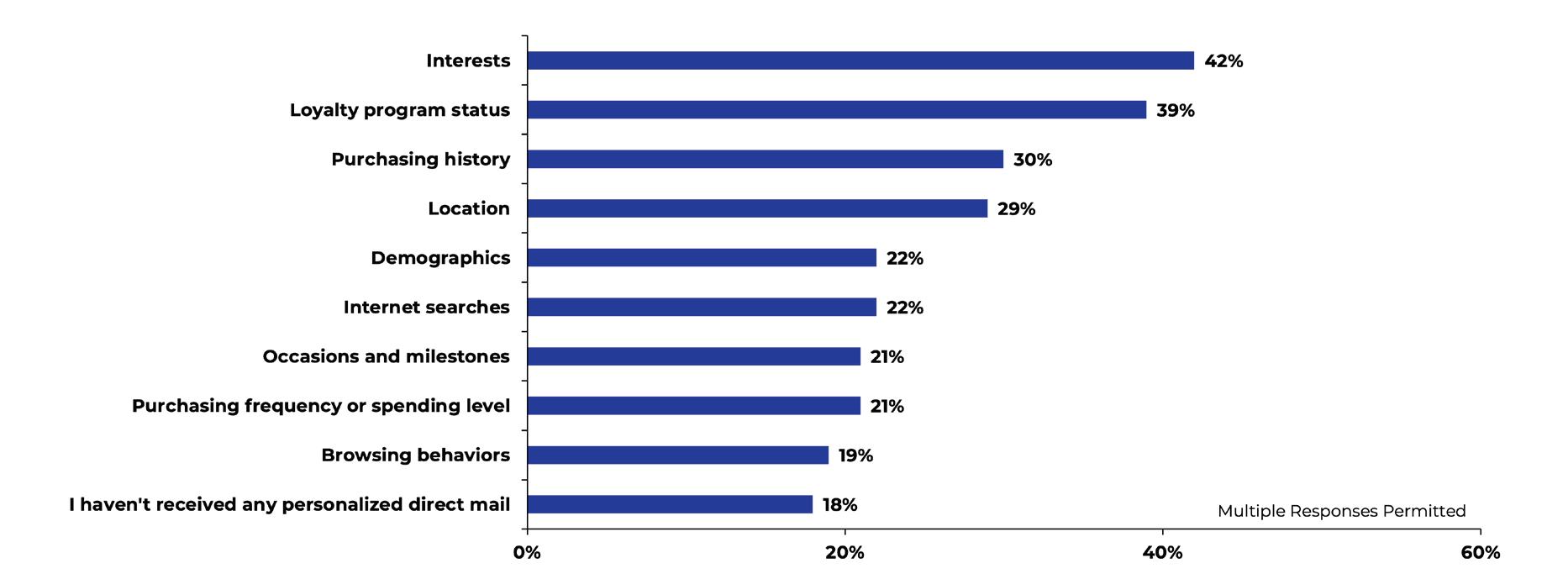
Occasions and Milestones: Deepen engagement by acknowledging personal events. Birthdays, anniversaries, or graduations provide a perfect opportunity to deliver timely, heartfelt, and memorable communications.
Browsing Behaviors: Don’t let valuable signals go to waste. What did a customer “almost” buy? If you consider abandoned carts and wish lists as critical indicators of intent, you can turn near misses into conversions.
Each of these segments can open the door to more personalized and relevant messaging. The true magic happens when you combine them strategically. When you layer these insights, the impact on your campaign’s effectiveness and your ROI multiplies exponentially.
In the past, creating highly segmented direct mail campaigns was often prohibitively expensive. Offset printing required long runs and incurred high setup costs, making personalization a luxury that few marketers could afford. Inkjet technology has changed all that. Today’s production inkjet presses enable service providers to print variable content at high speeds and with exceptional quality. This means that whether your clients are sending 500 targeted postcards or 50,000 uniquely personalized letters, inkjet technology makes sophisticated versioning both affordable and efficient. You can switch
images, headlines, offers, and even layouts from one piece to the next without compromising production speed.
This unparalleled flexibility transforms what were once static, one-size-fits-all campaigns into vibrant, high-performing, data-driven outreaches. Inkjet isn’t just a printing device; it’s the missing piece that brings your most sophisticated segmentation strategies to life.
The evidence is clear: segmentation powered by inkjet technology delivers superior outcomes. Across various industries, businesses that leverage segmented campaigns report significantly higher response rates and a stronger return on investment. For example, a national retailer can promote region-specific products that are directly tailored to local demographics, or a nonprofit organization can customize its appeals based on an individual donor’s past giving history. In each scenario, the ability to engage with recipients based on their unique context enhances engagement and prompts action. These are not just incremental improvements; they represent transformative shifts in campaign effectiveness.
As a print and mail provider, your role goes beyond simply producing materials. You are a vital strategic partner in your clients’ success. Start by assisting them in conducting a thorough audit of their existing mailing lists to uncover untapped segmentation opportunities. Ask insightful questions that encourage them to think differently. Here are a few examples:
What key insights do you have about your most valuable customers?
Are you fully leveraging that deep understanding in your current direct mail efforts?
Could your existing data support dynamic versioning based on customer behaviors or intents?
Once you’ve identified these opportunities, demonstrate how the power and flexibility of inkjet technology can turn these advanced and impactful strategies into profitable outcomes.
The true power of direct mail, enhanced by the dynamic capabilities of inkjet technology, lies in its ability to communicate directly with individuals. Your client’s list is more than just data; it’s an opportunity. When driven by intelligent segmentation and powered by inkjet technology, that list can elevate marketing results to new heights. In an industry where every impression counts, helping your clients connect more effectively with their customers is the most valuable service you can provide. After all, the path to print success doesn’t start with paper or ink. It starts with a smart list and a provider who knows how to use it.
Karen Kimerer of Keypoint Intelligence has experienced the many challenges of expanding current market opportunities and securing new business. She has developed a systematic approach to these opportunities, addressing the unique requirements of becoming a leader in our changing industry.
BY LEO RAYMOND
In a May 30 filing with the Postal Regulatory Commission, the Postal Service announced changes to its service measurement process. As stated in the filing:
“In this filing, the Postal Service provides notice to the Commission about revisions to the SPM Plan and Methodology Documents related to necessary changes to allow the Postal Service to collect and report service performance data at the 5-Digit ZIP Code level. These changes are consistent with and supportive of the operational initiatives and transition to 5-Digit to 5-Digit ZIP Code service standards proposed by the Postal Service in Docket No. N2024-1, and the Postal Service’s related intentions to implement updates to service performance measurement that will allow the Postal Service to generate service performance results at the 5-Digit to 5-Digit ZIP Code pair level…
“The Postal Service intends to implement a two-phased approach to enhance the SPM system to enable service performance measurement at the 5-Digit ZIP Code level. This will entail revisions to the methodologies for data gathering and reporting in Legs 1 and 3. These changes will, among other things, enhance our public-facing Dashboard by providing more granular data for public review.
“To enable service performance measurement at the 5-Digit ZIP Code level, the Postal Service will leverage a cluster sampling approach in conjunction with CPMS scans, census package data, and geo-location breadcrumbs to improve both the measurement capabilities and statistical controls and predictability for the sampling process. CPMS scans, which are performed daily on over 99 percent of collection boxes, will provide a quasi-census measure for Leg 1 measurement by identifying when a carrier
arrives at a collection box and collects the mailpieces. The CPMS scans will then be validated using a geo-fence, ensuring that collection box scans occurred at the physical collection box location. The geofence logic will also measure the arrival of carriers at the postal facility. Similarly, package delivery scans will be used in concert with mail delivery samples to validate Leg 3 measurement.”
Under the Postal Service’s new network model, “Leg 1” is from mail deposit to the origin Regional Processing and Distribution Center. “Leg 2” is between the origin and destination RPDCs, and “Leg 3” is from the destination RPDC to the addressee.
The agency further explained its “cluster sampling” concept:
“Cluster sampling is a statistical sampling method that allows large data populations to be divided into smaller ‘clusters’ with consistent features — such as geographic regions — where the overarching cluster sample results can be applied to the underlying elements of the cluster. The SPM system will leverage clusters based on regions, facilities, and volume density to ensure statistically significant sampling and reporting can be done at the 5-Digit ZIP Code level moving forward. Cluster sampling is a highly effective and cost-effective approach for sampling and re-porting at the 5-Digit ZIP Code level. In the circumstances where 5-Digit ZIP Codes have volume below statistical threshold — low volume density for geographical regions and force majeure incidents — performance will be imputed from the density cluster that encompasses the 5-Digit Zip Code. This approach will provide statistically significant and representative measurement for these 5-Digit ZIP Codes.
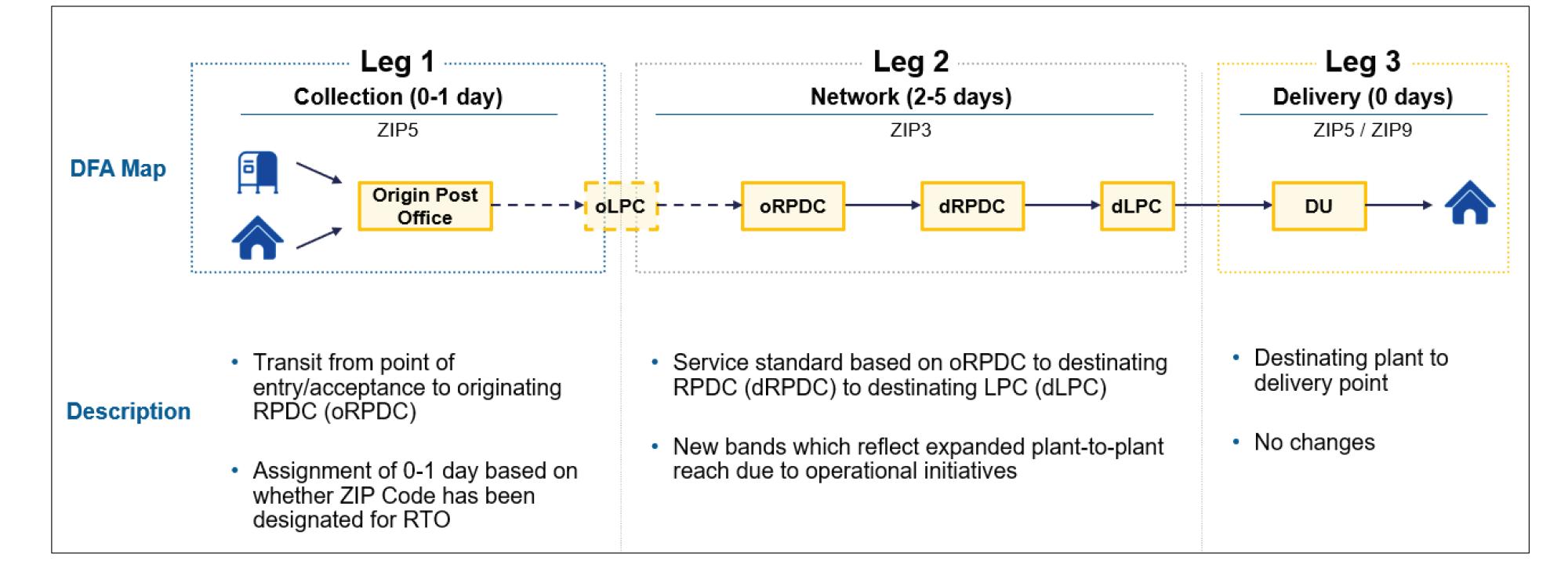
“Cluster sampling offers cost and time efficiency. Controlled random sampling performed within the cluster is predictive for all elements of the cluster, which will allow the Postal Service to impute data from clusters when individual reporting elements do not meet sample minimums, reducing overall number of samples as well as associated costs. Cluster sampling is also scalable. Appropriately designed clusters with a controlled sampling process are usable for both elements within the cluster as well as overarching higher-level clusters. Moreover, cluster sampling offers predictability given that sampling from well-constructed clusters enhances the consistency and interpretability of results.”
The USPS added that the first phase, involving “Leg 3,” will be implemented on July 1, and the second phase, regarding “Leg 1,” will be effective September 1.
As might be expected, the filing is rife with positivity about how the new process will “measure service performance in an accurate, reliable, and representative manner.” As regular observers of the USPS and readers of its official statements know, former postmaster general Louis DeJoy’s acolytes — who are still in USPS HQ and executing his Plan — always described whatever they were doing or proposing in glowing terms guaranteeing success and great results.
Similarly, such statements were often long on generalities and short on specifics — and the proposed changes to SPM, further padded by statistical buzzwords, are no exception.
One telling reference is to “the operational initiatives … proposed by the Postal Service in Docket No. N2024-1.” That docket proffered a measurement scenario based around the new network model and the deployment of Regional Transportation Optimization, which ended afternoon collections at post offices more than 50 miles away from an RPDC — more than 70% of the nation’s ZIP Code areas.
In presenting the proposed changes and the “cluster sampling” it will employ, the USPS is silent on how the “Day 0” it assigns to mail from RTO-impacted office will be reflected in its measurement process. Regardless of whether a carrier scans in collection mail or its arrival at the serving post office, if that mail involved is assigned “Day 0” it’s effectively deferred from inclusion in service performance calculations until it’s picked up the following business day. Perhaps the homogenization inherent in “cluster sampling” is expected to allow the better service for customers of non-RTO offices to obscure the true service rendered to the relatively smaller number of customers at RTO-offices, in turn yielding numbers supportive of upbeat service claims.
Similarly unexplained is how measurement will work if the agency’s model (see image on previous page) treats the travel from the destination plant to delivery as another “Day 0.”
Fortunately for the USPS, the popular media and most customers don’t look behind its claims of service to see how selective measurement practices can be used to misrepresent reality. Commercial mail producers and their clients should not be so naïve: the Postal Service isn’t going to build a service measurement system that it isn’t sure will yield favorable results; those results should be evaluated accordingly.
Leo Raymond is Owner and Managing Director, Mailers Hub. He can be reached at lraymond@mailershub.com.
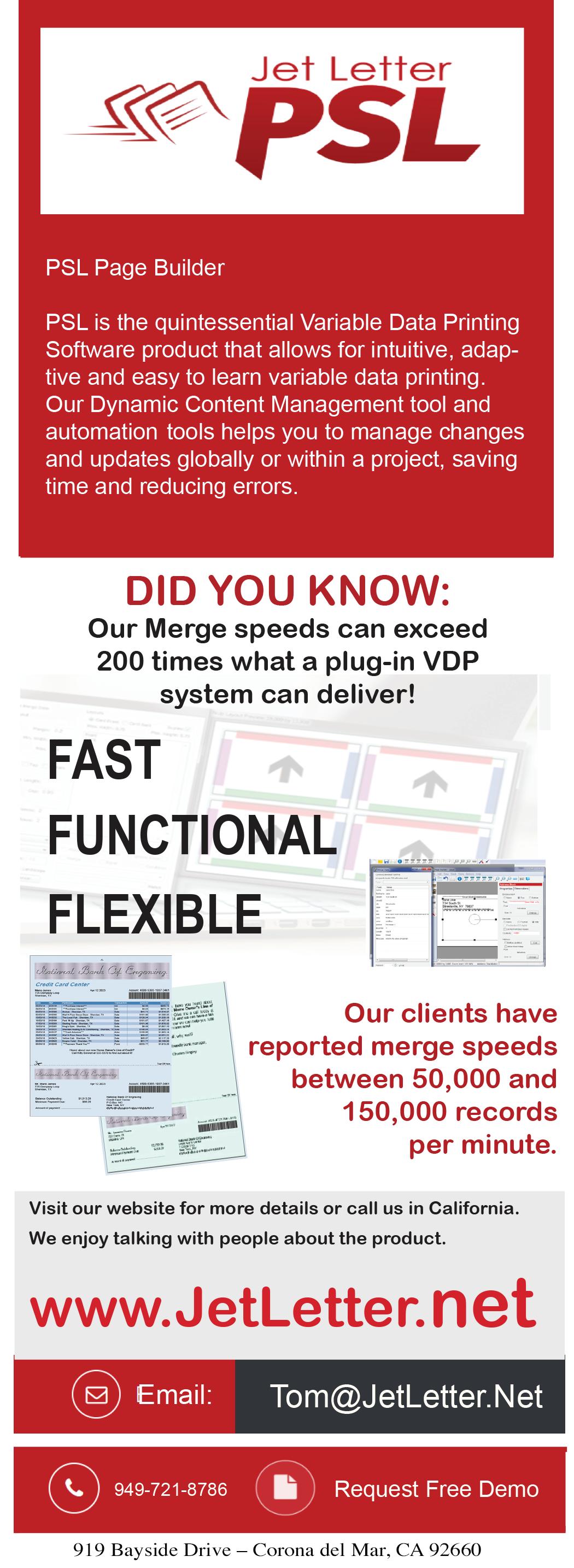
BY MIKE PORTER
Print and mail professionals continuously seek ways to improve mailing campaign performance while managing costs. One approach is to update existing mailing projects to increase their impact and efficiency. This is particularly relevant now, as upcoming postage rate increases can be expected to influence client business decisions about postal mail expenses.
Simple adjustments can result in significant improvements. Various methods include changing the piece format, integrating digital elements, refining the mailing list, adjusting mail frequency, or transitioning to a trigger-based on-demand system. Even modifying document layouts can effectively reduce page counts and lower expenses.
When mail was the main customer communication channel, letters were the natural choice. We needed the space offered by full size letters to communicate all the necessary information.
Some applications needed multiple pages, turning high page-count documents into flats.
Today, easily accessed digital information makes it possible to reduce the data presented in printed form. Summary statements still deliver the critical information most customers need. A QR code or pURL directs them to online data sources that convey lengthy information like phone call details or credit card transactions.
Mailers can satisfy customer demands for paper communications at a much lower cost by converting variable page count bills and statements into summary formats like folded self-mailers. In a similar strategy, altering the size or page count of catalogs and effective targeting can reduce the production and postage costs without sacrificing response rates.
Not mailing to anyone unlikely to respond is an ideal way to trim marketing
expenses while simultaneously improving campaign ROI. Dropping duplicates, correcting addresses for people who have moved, and eliminating records with undeliverable addresses should be standard practice. Further savings are possible, however, by making better decisions about who is most likely to respond to the offer.
Some list selection strategies are simple, like not sending offers about landscape services to houseboats. Other criteria can be more complex, using the power of AI to compare known data and individual customer behavior to an ideal customer profile. This process allows you to remove names from the mailing list if analysis predicts low chances they will convert.
Sometimes, simply altering the way you present information on the page can reduce the production and postage costs of mailed communications.
You don’t have to manage this analysis yourself. I spoke with a company exhibiting at the National Postal Forum that offers mailers this kind of data analysis and record selection as a service that mailing companies can offer their clients.
Note that trimming prospective customers from a mailing list does not mean you won’t mail to them at all. Marketers may decide to mail to the lower-converting customers less often, or to send them a piece that is less expensive to produce and mail.
Variable data printing allows mailers to match the right customer with the right offer. Extending that offer at the right time will increase the effectiveness of direct mail marketing. Triggers tied to individual customers can vary, including upcoming warranty end dates, changes in credit ratings, customer birthdays, average life of a previously purchased product, and more. Other triggers can be from external events, such as political shifts, unusual weather, or local sports team performance.
To accommodate triggered mail, print/ mail service providers may need to alter some aspects of their document production workflow. But depending on the clients and the applications, adding triggered direct mail can allow some companies to reduce their reliance on large batch mailings in favor of daily mail that connects with their customers when they are most receptive to the offers.
Sometimes, simply altering the way you present information on the page can reduce the production and postage costs of mailed communications. We achieved large savings for a client by reformatting regulated terms and conditions documents. Few people ever read these pages written by corporate lawyers. We narrowed the margins and reduced the font size. We cut the page count in half, remained in compliance, and never received a single complaint from customers.
Look for content that appears on printed pages to see if it serves a purpose. Check the rules, as we did in the example above, to find out they didn’t actually dictate the font size (as was widely believed in the organization). Eliminate redundancy and obsolete text. You may reduce page counts and offset some of the postage increases that cause clients to rethink their postal strategies twice a year.
A mix of smart list management, datadriven triggers, and innovative document design applied to existing jobs can enhance the efficiency and effectiveness of direct mail marketing or transactional documents. These strategies help reduce costs and improve customer engagement, reinforcing the idea that mailed communications is a worthy investment, even as postage costs rise. By leveraging these approaches, print/mail service providers can stay competitive and preserve work from their existing clients.
Mike Porter at Print/Mail Consultants and PMC Content Services creates content that helps attract and retain customers for companies in the mailing and document industry and he assists companies as they integrate new technology. Learn more about his services at www.pmccontentservices.com. Follow @PMCmike on X, or send him a connection request on LinkedIn.

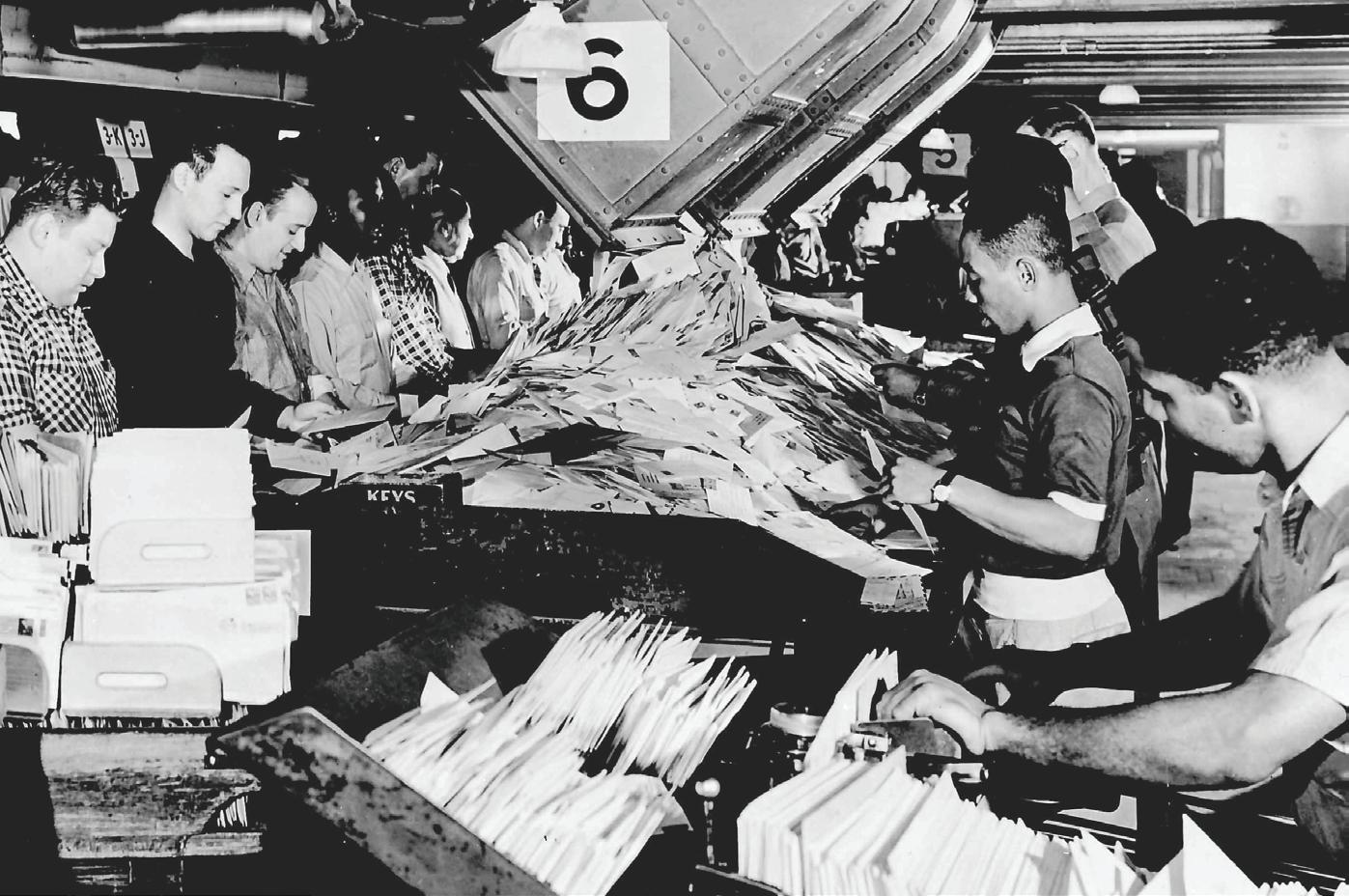
By Amanda Armendariz
The United States Postal Service, a cornerstone of American communication, has certainly evolved from its inception in the 1700s. Indeed, the founders would probably consider the organization unrecognizable today, given the speed of delivery and the interconnectedness of the vast delivery footprint. But what hasn’t changed is the commitment to ensuring that every American, regardless of location, receives their mail.
Pre-American revolution, the postal system in the colonies was rudimentary, at best. Correspondence within the New World was transported by whomever could be found to deliver the piece. However, most correspondence took place between the colonists and their loved ones back in England, and the first official notice of a postal service in the colonies appeared in 1633. In 1639, Richard Fairbanks’ tavern in Boston was designated by the General Court of Massachusetts as the official site of mail delivery going to or coming from overseas.
These early communication channels were painfully slow. To get a letter to Fairbanks’ tavern could take days, not to mention the time it then spent at sea before being delivered to the recipient in England. In this current environment of two-day (sometimes same-day!) delivery from companies like Amazon, the glacial pace at which mail pieces were delivered almost four centuries ago seems unfathomable.
With the birth of the United States of America, the need for a more reliable postal service became clear. In 1775, Benjamin Franklin was appointed the first Postmaster General by the Continental Congress.
Franklin brought substantial prior experience to the PMG position. In 1737, he became postmaster of Philadelphia after Andrew Bradford, who had previously held the title, was removed from his post by the British government after not filing his financial reports for three years in a row. While the salary wasn’t large (postmasters worked on commission, keeping 10% of the postage they collected from customers), Franklin earned the respect of the British government with his extensive bookkeeping skills, and he was appointed comptroller of the entire American colonial system. In this position, he kept track of the finances for 13 American post office stretching over a distance of 1,500 miles.
According to Neither Snow Nor Rain: A History of the United States Postal Service by Devin Leonard, Franklin’s time as postmaster of Philadelphia greatly influenced his vision of the future of the colonies. “He began to think of the colonies not as individual provinces but as parts of a potential nation bound together by shared institutions like the Post Office,” Leonard states. Hence, when Franklin became joint postmaster general of the colonies in 1753 (a position he held until 1774), he insisted there be properly surveyed and marked routes from Maine to Florida (the origins of Route 1), overnight postal travel between the critical cities of New York and Philadelphia be instituted, and a standardized rate chart based upon distance and weight created.
After the US Constitution was ratified in 1788, the postal network only continued to grow. In 1792, President George Washington signed the Postal Service Act, which officially
The Post Office Department issued its first postage stamps on July 1, 1847. According to the USPS’s Postal Facts page, “Previously, letters were taken to a Post Office, where the postmaster would note the postage in the upper right corner. The postage rate was based on the number of sheets in the letter and the distance it would travel. Postage
could be paid in advance by the writer, collected from the addressee on delivery, or paid partially in advance and partially upon delivery.”
On March 3, 1847, however, Congress authorized United States postage stamps, with the first general issue postage stamps going on sale in New York City on July 1, 1847. The five-cent stamp depicted Franklin; the ten-cent, Washington. Washington has appeared on more US postage stamps than any other person.
established the United States Post Office Department as a government-run entity. This legislation was the foundation for a national mail system, and it formally created the office of the Postmaster General, with the responsibility for overseeing the distribution of mail across the entire country. Samuel Osgood served as PMG from 1789, when the Constitution came into effect, until the government moved to Philadelphia in 1791. At this point, Timothy Pickering took over and once the Postal Service Act was signed in 1792, his post had greater legislative legitimacy and more effective organization. Pickering served in this position until 1795.
One interesting aspect of the 1792 law concerned the distribution of newspapers. According to Wikipedia, “Since news was considered crucial to an informed electorate, the 1792 law distributed newspapers to subscribers for 1 penny up to 100 miles and 1.5 cents over 100 miles; printers could send their newspapers to other newspaper publishers for free. Postage for letters, by contrast, cost between 6 and 25 cents depending on distance. This subsidy amounted to roughly 0.2 percent of US Gross Domestic Product (GDP), according to McChesney and Nichols.”
The foundation for this subsidy was perhaps laid almost two decades before, when William Goddard, a Patriot printer who was losing patience with the Royal Mail for being unable to reliably deliver his Pennsylvania Chronicl e to its readers (or deliver crucial news for the paper to Goddard), shared his plan for a “Constitutional Post” with the Continental Congress on October 5, 1774. Congress was receptive to his plan, although it waited until after the Battle of Lexington and Concord on April 19, 1775 to act.
It may seem strange to us, who have all grown up with the mail carrier being a familiar sight in our residential and business areas on a daily basis, but it wasn’t until the late 19th century that free home delivery of mail was introduced (first in cities, then in rural areas).
Prior to 1863, postage only paid for the delivery of mail from Post Office to Post Office. Citizens usually picked up their mail themselves, although post offices in some cities gave recipients the option to pay an extra one- or two-cent fee for letter delivery or use private delivery firms. In 1862, PMG Montgomery Blaire suggested free delivery of mail by salaried letter carriers, which he felt would “greatly accelerate deliveries,

and promote the public convenience.” His thought process was that if utilizing the postal system was more convenient, more people would use it more frequently. He bolstered his argument by pointing to increasing postal revenues in England, which already had adopted free city delivery.
Subsequently, an Act of Congress of March 3, 1863, effective July 1, 1863, “provided that free city delivery be established at Post Offices where income from local postage was more than sufficient to pay all expenses of the service,” according to the USPS’s Postal Facts page. “For the first time, Americans had to put street addresses on their letters.”
As the American population and economy grew, so did the number of mail pieces entering the mail stream on a daily basis, and new technology allowed pieces to reach their destinations more quickly. On May 15, 1918, for example, the Post Office Department began airmail service between New York and Washington, D.C., via Philadelphia — the nation’s first regularly scheduled airmail route. This service was originally staffed by Army pilots, but on August 12 of that year, the Post Office Department took over all phases of airmail service, using newly hired civilian pilots. Two years later, a transcontinental airmail route was completed, linking New York with San Francisco.
In 1970, the Postal Reorganization Act abolished the then-US Post Office Department, which was a part of the Cabinet, and created the United States Postal Service, a “corporation-like independent agency authorized by the government as an official service for the delivery of mail in the United States.”
The 70s, 80s, and early 90s saw the healthy mail volumes that characterized this medium’s heyday. However, as we all know, the advent of the internet caused mail volumes to plummet sharply, and we will likely never again see the number of mail pieces
as we did in years past. However, mailers have learned to embrace the digital offerings available to them, as they have found that hard copy mail combined with digital advancements provides the most effective engagement for their customers. While volume declines are concerning, mailers and the industry as a whole should focus on the fact that mail is still considered the most trustworthy communication method available. While we have seen many changes over the past 250 years, what hasn’t changed is the importance of the printed mail piece, and it will continue to be a cornerstone of American society for years to come.
When many Americans think of the postal delivery system of days gone by, the Pony Express is an institution that immediately springs to mind. Despite being remarkably short-lived, the Pony Express continues to live on in the minds of many Americans.
Created in 1860, the Pony Express was the brainchild of William H. Russell. According to Rickie Longfellow’s article on the Highway History page of the Federal Highway Administration’s website, “[Russell’s] ad in the newspapers seeking riders read: ‘Wanted. Young, skinny, wiry fellows not over 18. Must be expert riders willing to risk death daily. Orphans preferred.’” However, the requirements for riders were later loosened, and riders ranged from as young as 11 to as old as mid-40s.
St. Joseph, Missouri, was the starting point for the direct 2,000-mile route to the West, much of which was considered unknown land except for a few settlements and military forts. According to Longfellow’s article, Russell and his partners built relay stations every five to 20 miles (about 150-190 stations in total), where riders could obtain fresh horses.
The fastest piece of mail in the history of the Pony Express was President Lincoln’s inaugural address, which was carried to California in seven days and 17 hours. Perhaps the Pony Express’s greatest achievement in terms of the nationwide delivery network was the fact that its riders demonstrated that the Central Route to California was usable all year long. On October 24, 1861, however, the transcontinental telegraph line was completed, rendering the Pony Express essentially obsolete.
By Greg Brown

Addresses might seem almost mundane, but they are quietly doing some of the heaviest lifting in your tech stack. Acting as a foundational link between people and services, a clean, standardized, enriched address record doesn’t just streamline operations — it builds trust. Few data points are as deceptively powerful, or as consistently underestimated, as the “simple” address.
Retailers are often the most vocal about the cost of bad addresses, pointing to lost packages, missed deliveries, and mounting returns. But the importance of address accuracy extends well beyond the shopping realm. In financial services, address data plays a central role in fraud prevention and regulatory compliance; in healthcare, patient safety and health outcomes. The stakes are high, and the benefits of getting it right are even greater.
New construction creates about 1.5 million new addressable locations annually. In the same timeframe, up to 20% of businesses move, close, or change ownership. These changes alone result in outdated or misclassified addresses that significantly degrade the quality of databases over time. Complicating matters further, physical values, where a structure actually exists, may be different from postal definitions where mail is delivered or even the legal address used in taxation or property registration.
So, what are the keys to ensuring customer addresses are working for you and your business? Here are five best practices to elevate address data quality and unlock its full value as a competitive advantage.
Over 20% of addresses in business databases are inaccurate, incomplete, or out-of-date. Worse, these errors originate at the point of data entry and then cascade downstream to impact a business at every level. Whether entering a shipping address for an online purchase, registering a bank account, or checking into a health clinic, the first touchpoint is critical and often where address quality breaks down. Misspellings, missing unit numbers, and format inconsistencies are common… and expensive for the long term.
Integrate tools, like real-time address autocompletion and validation, to prevent errors before they enter the system. In a smooth and seamless process, the customer is presented with only correct address options. Benefits are diverse depending on the industry sector. In e-commerce applications, typos are caught at checkout, in turn reducing cart abandonment and streamlining order fulfillment. Sellers avoid misdelivered goods and failed promotions based on physical/ postal mismatches. For financial institu-
tions onboarding new customers, verified address data ensures a clean foundation for electronic identity verification (eIDV). No more missed “Know Your Customer” red flags or fraud risks when legal versus postal addresses do not align.
Correct addresses help healthcare organizations avoid communication gaps with patients that can lead to care delays or HIPAA compliance risks. It’s essential data that supports patient matching, or the critical ability to identify and link records for the same patient within and across systems and organizations. This monumental challenge shapes the Project US@ initiative, a nationwide program that standardizes address formats to enhance patient matching and interoperability of records within and between healthcare organizations.
Good address data is more than accurate, it’s complete. To unlock deeper insights and utility, combine a verified street address with additional contextual details. For example, rooftop level geocoding can improve precision in location-based services, reducing risk and improving service quality across sectors.
Adding geolocation, apartment indicators, phone numbers, building, or known delivery types helps retailers optimize lastmile deliveries and reduce failed drop-offs.

Financial services providers use enrichment to validate that a customer lives at a known, serviceable address and isn’t hiding risk behind a P.O. box. These details are critical for combating synthetic identity fraud, where fabricated profiles are tied to false or outdated addresses.
In healthcare, enrichment helps providers fill in data gaps, such as missing apartment numbers or outdated phone details. Better and more complete data ensures continuity of care and powers predictive analytics that improve outcomes.
Data held in siloed systems, coupled with minor variations in spelling or formatting, cause a cascade of problems. A business may face compliance headaches, distortion in their analytics, or wasted marketing resources. Across industries, duplicate records represent hidden danger and require integration of address standardization and deduplication tools. This is no small problem, as enterprise systems are estimated to have structural errors in up to 25% of addresses.
Healthcare applications provide an example, where even slight variations in an address (“123 Main St.” vs. “123 Main Street, Apt B”) can lead to mismatched records and patient safety risks. Con-
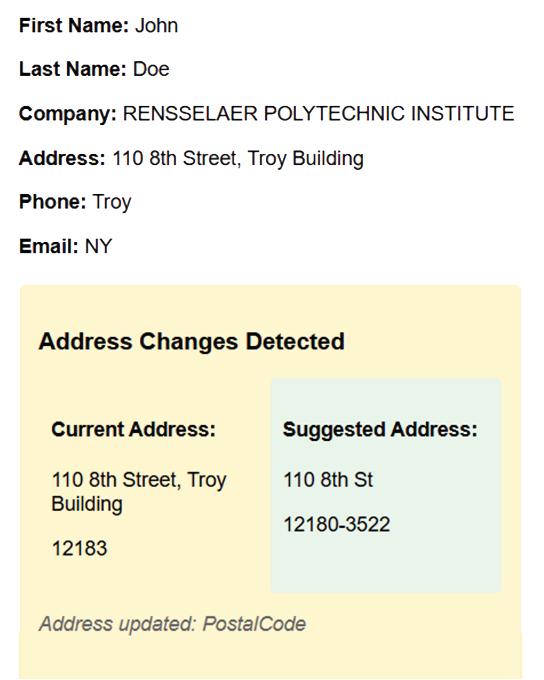
There are over 210 million addresses in the United States and they change all the time. People move residences, homes are sold or refinanced and ZIP Codes are updated. Advances in data quality tools help data managers keep up with the fluidity. Some solutions give customized, proactive alerts any time a record is updated (for example, for address updates, change of address, or property transactions).
versely, records that are standardized and deduplicated result in a Golden Record for each patient, a single source of truth that ultimately improves outcomes and operational efficiency. Some retailers and financial servicers would say this level of address perfection is equally as important for the life and health of their businesses, as they rely on deduplication tools to merge customer records, clean CRM systems, avoid over-targeting, and stem bank fraud.
Outdated or incomplete address data breaks the chain of communication, no matter if it’s a lab result, loan application, or legal notification. This is a non-stop challenge, as about 11% of the US population moves yearly. To avoid losing reach and possibly regulatory footing, maintain an ongoing data refresh process and strategy.
Solutions like USPS National Change of Address (NCOALink) services help keep databases current. While this is not the only method of updating people and businesses that have moved, it is the only method that identifies undeliverable-as-addressed (UAA) mail prior to a
mailing. The mover, however, must file a change of address for NCOA to have the correct records — something that certain demographics like millennials tend to resist. To ensure the best results, a data-focused approach ideally pairs NCOA operations with proprietary change-ofaddress (PCOA) tools for an even more complete picture. The best strategy is not one or the other, and smart data tools fill in the blanks with the strongest data culled from multiple sources.
Understanding the type of address is just as important as validating its existence. Is the location a residence or business? An apartment building or a standalone home? A rural PO box or an urban high-rise with designated delivery entrances? Integrate “address intelligence” tools to help you choose the best delivery methods, calculate more accurate shipping costs, and manage customer expectations with confidence.
Banks, for example, use address types to help flag high-risk or mail-forwarding addresses. It’s data that supports their efforts to detect questionable profiles, assessing credit worthiness and screening for potential fraud or synthetic identities. Retailers can calculate shipping costs more accurately; they can optimize last-mile delivery by routing to specific building entry points and managing delivery requirements for residential versus business addresses. With insight into geographic trends, healthcare providers can identify at-risk populations and align their outreach with community health goals.
Addresses aren’t just static data. They’re dynamic, multi-faceted identifiers. And they have a dramatic impact on how a business operates and connects with its customers.
Do we know where this person is — and that they are who they say they are? Consistent data quality practices answer these questions, recognizing and mastering the strategic power of the address.
Greg Brown is Vice President of Global Marketing at Melissa, a provider of contact data quality and identity verification tools. Melissa’s solutions integrate seamlessly into CRM, e-commerce, and master data management platforms to support the full data quality lifecycle. Connect with Greg at greg.brown@ melissa.com or on LinkedIn.
BY MIKE SANDERS

As the use of artificial intelligence becomes more prevalent across industries, mail operations face new opportunities and challenges. Considering the ethical, legal, and operational impact of AI adoption is essential for print and mail providers, where protecting sensitive customer information is part of daily operations. AI certainly offers many benefits, from improving address hygiene to automating quality control and flagging anomalies in production, making it possible to streamline tasks and enhance accuracy. However, as AI’s role grows in the print and mail workflow, so do the associated risks, especially those regarding security and privacy.
Cyber threats have become more sophisticated alongside AI. Phishing and smishing attacks now use AI-generated content that mimics real customer messages, putting call center scripts, return mail communications, and other customer touchpoints at risk. This raises the stakes for mailers who routinely manage protected information, such as account numbers, social security numbers, medical data, and more.
Add to that the impact of deepfake fraud, where AI-generated voices or images could be used to impersonate authorized senders or forge document requests. This poses grave concern in environments where identity verification and document integrity are paramount.
The potential for manipulated documents is prevalent for mail centers producing checks, notices, or official correspondence.
AI thrives on data, so proper oversight is imperative to prevent data exposure by employees feeding names, addresses, and payment information into AI models. Mailing operations, particularly those serving regulated industries like healthcare, insurance, or finance, must prioritize securing this data across every touchpoint, from data ingestion to print production and mail delivery.
Trust remains central to customer communications. Print and mail operations must be transparent about how AI is used in document workflows, whether in the composition, routing, or tracking stages. Assembling a cross-functional team to create a company AI policy should be at the top of the list for every organization regardless of size or industry.
Establishing clear guidelines for how AI should be used across your organization creates a framework for harnessing its benefits responsibly. If you don’t yet have an AI policy in place, here are six reasons why it’s essential to develop one now:
Ethical guidelines and bias mitigation
AI systems can reinforce biases and result in discriminatory practices without careful management. A policy for AI use
can establish guidelines for ethical AI development and application, promoting fairness, transparency, and inclusiveness in decision-making processes.
2. Data privacy and security adherence
Without adequate oversight, AI usage, which depends heavily on data that often includes sensitive information about customers and employees, poses the risk of data breaches or violations of privacy laws like GDPR, CCPA, or other specific industry regulations.
3. Accountability and human oversight
While AI is powerful, it is not without flaws. Mistakes in AI decision-making can have serious repercussions, ranging from financial losses to damage to reputation. A policy for AI use should include accountability measures and requirements for human oversight to ensure that AI-driven decisions are monitored and evaluated and risks are minimized.
4. Promoting transparency
Many AI models function as “black boxes,” making it challenging to understand how decisions are reached. This lack of transparency can create mistrust among employees, customers, and stakeholders. A clear AI policy should encourage the use of explainable AI, ensuring that decisions can be justified and audited when necessary.
5. Workforce integration and employee training
The concern that AI can potentially enhance or replace certain job functions can lead to anxiety about job displacement and the
redefinition of roles. It is essential to specify how AI will be incorporated into the workforce, offer employees training on AI tools, and ensure ethical labor practices in AI-driven automation.
6.
Adherence to regulatory compliance and industry standards AI regulations are evolving swiftly, which means companies must stay ahead of legal requirements to avoid penalties and reputational harm. A well-structured policy for AI use helps businesses comply with current and emerging AI regulations, industry standards, and best practices.
AI is transforming mail center’s operations, but the risks can outweigh the benefits without structure and safeguards. As one of the last lines of defense in the secure delivery of business-critical documents, mailing professionals need to lead with policy, transparency, and vigilance.
As companies integrate AI into their processes, the commitment to data security, regulatory compliance, and ethical automation must remain the same. Creating a responsible AI policy is the next step in protecting what matters most: your customers’ privacy and trust.
Mike Sanders is Director of Information Systems for Datamatx, one of the nation’s largest privately held full-service providers of high-volume print and electronic transactional communications. With over 35 years of experience leading IT strategy and operations, Sanders specializes in driving digital transformation, optimizing system performance and ensuring robust cybersecurity. Visit Datamatx at www.datamatx.com.
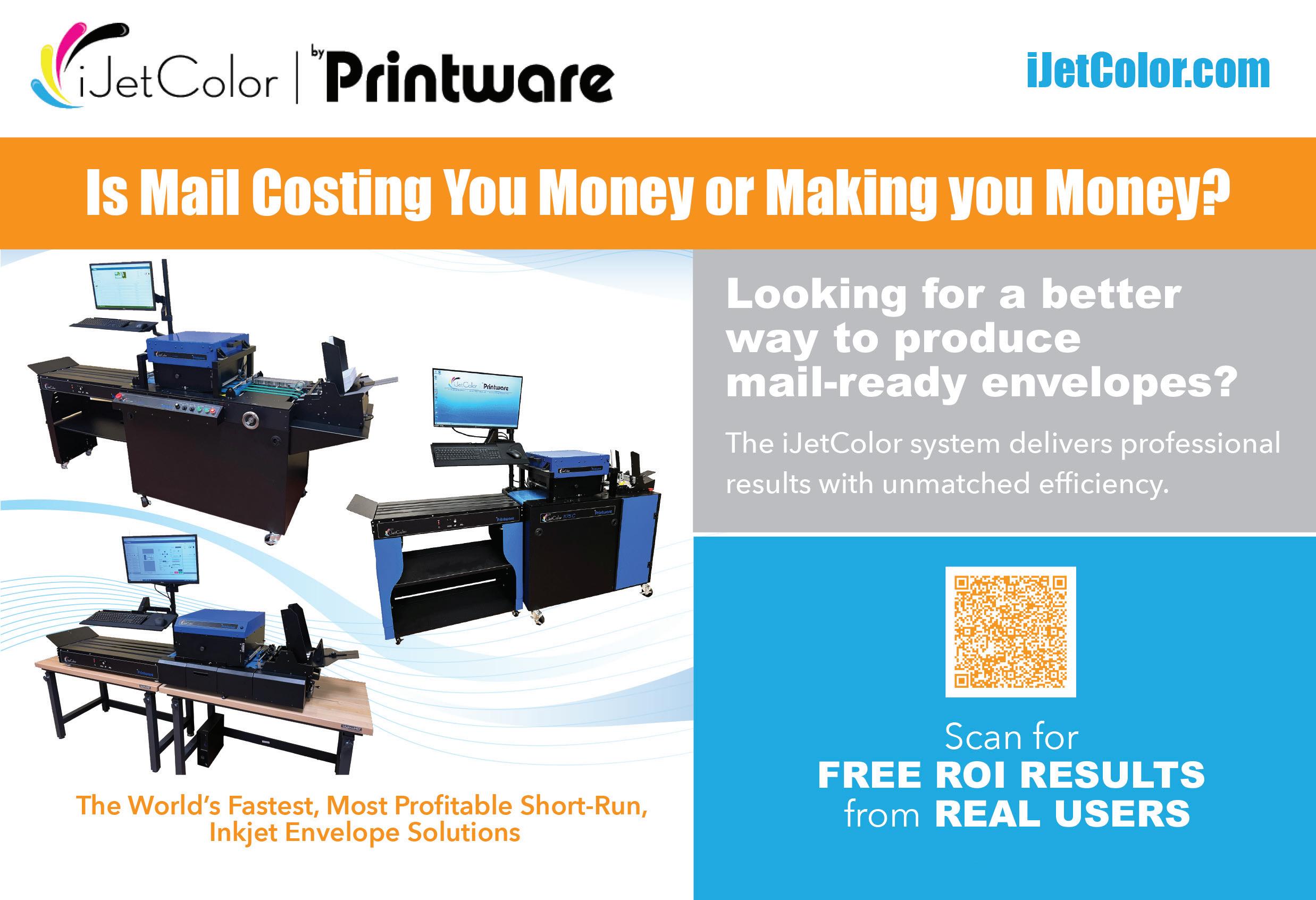
By Bob Rosser and Brian Cook

Direct mail has been a staple of marketing strategy for decades, consistently delivering strong response rates and ROI. Yet, in a world dominated by digital advertising, many marketers hesitate to invest in or evolve their direct mail strategies — fearing complexity, rising costs, and outdated methods.
The reality? Direct mail has undergone a dramatic transformation. Advances in data analytics, AI, automation, and digital printing have redefined what’s possible, making direct mail one of the most precise and impactful marketing channels available today.
Direct mail has always been seen as a heavyweight channel — one that delivers results, but often requires extended lead times and a rigid, complex process. Since its inception, marketers had to plan months in advance, locking in creative and targeting decisions early, with limited room to shift course once execution was underway.
Now, technology has fundamentally changed how direct mail is executed, making it as agile and responsive as digital marketing.
Faster execution cycles: Automated workflows and AI-driven decision-making significantly reduce lead times, enabling mailers to quickly test and refine campaigns after launch.
More flexibility in targeting and personalization: Direct mail can now adapt dynamically to consumer behaviors, personalizing messaging at an individual level.
Improved omnichannel coordination: Direct mail is no longer an isolated touchpoint — it seamlessly integrates with traditional and digital channels, enhancing the overall customer journey.
Direct mail is no longer the set-it-and-forget-it channel. It has evolved into a nimble, data-driven channel — capable of rapid adjustments, real-time targeting, and personalized delivery at scale.
Direct Mail: Precision Targeting for Maximum
Modern marketing demands precision — not just in selecting the right audience, but in delivering the right message, at the right time, through the right format.
Consumers expect personalization, and marketers who fail to leverage data are missing out on direct mail’s full potential. Data is no longer just about who to target — it informs what to send, how to craft the offer, and when to deliver it for maximum impact.
Hyper-personalization at scale: AI and advanced data analytics allow campaigns to tailor messages based on real-time customer needs — whether it’s a milestone or a shift in behavior.
AI-driven segmentation: Predictive modeling helps identify high-value prospects, ensuring marketing dollars are spent on audiences most likely to convert.
Dynamic package design: Variable componentry enables the creation of multiple, customized mail packages within a single production run, ensuring cost efficiency without sacrificing hyper-personalization.
By leveraging thousands of behavioral data points, marketers can transform direct mail into a highly strategic, response-driven channel that moves beyond generic messaging and delivers true one-to-one communication at scale.
Marketers are in a constant battle for consumer attention. Digital fatigue is real. Direct mail cuts through the noise. It provides a tangible, trusted, and disruptive marketing moment — one that captures attention and drives action in a way digital simply cannot.
The average response rate of direct mail is around 2.7% to 4.4%, while email has around 0.6% (the Business Research Company).
Consumers spend an average of 1.6 minutes with a direct mail ad, compared to 1.1 minutes for digital ads (The Financial Brand).
When integrated with digital campaigns, direct mail can increase conversion rates by up to 40% (USPS).
Direct mail isn’t replacing digital — it’s enhancing it. By combining direct mail with QR codes, PURLs, and retargeting strategies, marketers can create a seamless omnichannel journey that drives stronger, more measurable engagement.
Testing has always been a cornerstone of effective marketing — but it’s no longer about basic A/B comparisons. Today’s marketers are adopting a dynamic test-and-learn mindset, one that embraces rapid iteration and experimentation to unlock new performance breakthroughs.
The direct mail industry has traditionally moved slowly, but rising costs and increased demand for results have created new urgency. Marketers are embracing testing to explore the “art of the possible” — rethinking legacy strategies and transforming best practices to align with a future state that’s already within reach.
Modern direct mail empowers marketers to test more variables at once, faster and more cost-effectively than ever before. Technology enables campaigns to evolve continuously, guided by performance data and driven by precision.
Multivariate Testing (MVT): Marketers can test multiple elements — such as envelope messages, letter visuals, and package formats — all within a single campaign. This accelerates insights and avoids the delays of old-school sequential testing.
AI-assisted tools: Intelligent platforms amplify the value of available data by enabling marketers to identify and target
ever-finer segments of their audiences. These tools support personalization strategies that are both scalable and measurable.
Continuous optimization: With real-time performance data, marketers can refine creative, offers, and formats dynamically — allowing for consistent improvements throughout the campaign lifecycle.
The biggest barrier isn’t technology — it’s mindset. Marketers who move past legacy processes and embrace a test-and-learn culture are unlocking real growth and measurable results, faster than ever before, in today’s competitive environment.
Cost remains one of the biggest concerns for direct mail marketers. Rising paper and postage costs often lead brands to cut back on mail volume — but that’s the wrong approach. With the technology tools available to marketers today, it’s possible to generate more yield from existing budgets simply by mailing smarter — stretching the power of every marketing dollar to fuel growth.
Instead of reducing volume, marketers should optimize production and distribution — ensuring that every dollar spent on direct mail delivers maximum value.
Single-stream production: Advanced print and mail manufacturing technology allows multiple test packages to be run within a single mail stream at the same postage rate — reducing costs while enabling high-level personalization.
Automated workflows & AI-driven decision-making: Streamlined processes improve speed to market, reduce cycle time after new learnings, and ensure budget efficiency.
Postal optimization strategies: Strategic mailing techniques help marketers execute large-scale campaigns without excessive spending.
Direct mail can be a highly cost-effective channel — especially when supported by smart strategy and efficient execution. With the right approach, marketers can control costs, maximize their budget, and drive stronger results.
The evolution of direct mail isn’t coming — it’s already here. No longer a static print medium, it’s now a dynamic, data-driven channel that deepens customer engagement and drives measurable business results. To succeed in this rapidly evolving landscape, marketers must:
Leverage data and AI to create hyper-personalized, high impact mail pieces.
Implement real-time testing and automation to continuously optimize campaigns.
Use advanced manufacturing and postal strategies to reduce costs and increase efficiency.
Integrate direct mail with digital channels to enhance engagement and response rates.
Marketers who embrace this transformation will unlock stronger results and deeper customer connections. Are you ready to rethink direct mail and take full advantage of its potential?
Bob Rosser is Director of Postal Affairs, IWCO. Brian Cook is Vice President of Marketing Strategy, IWCO.
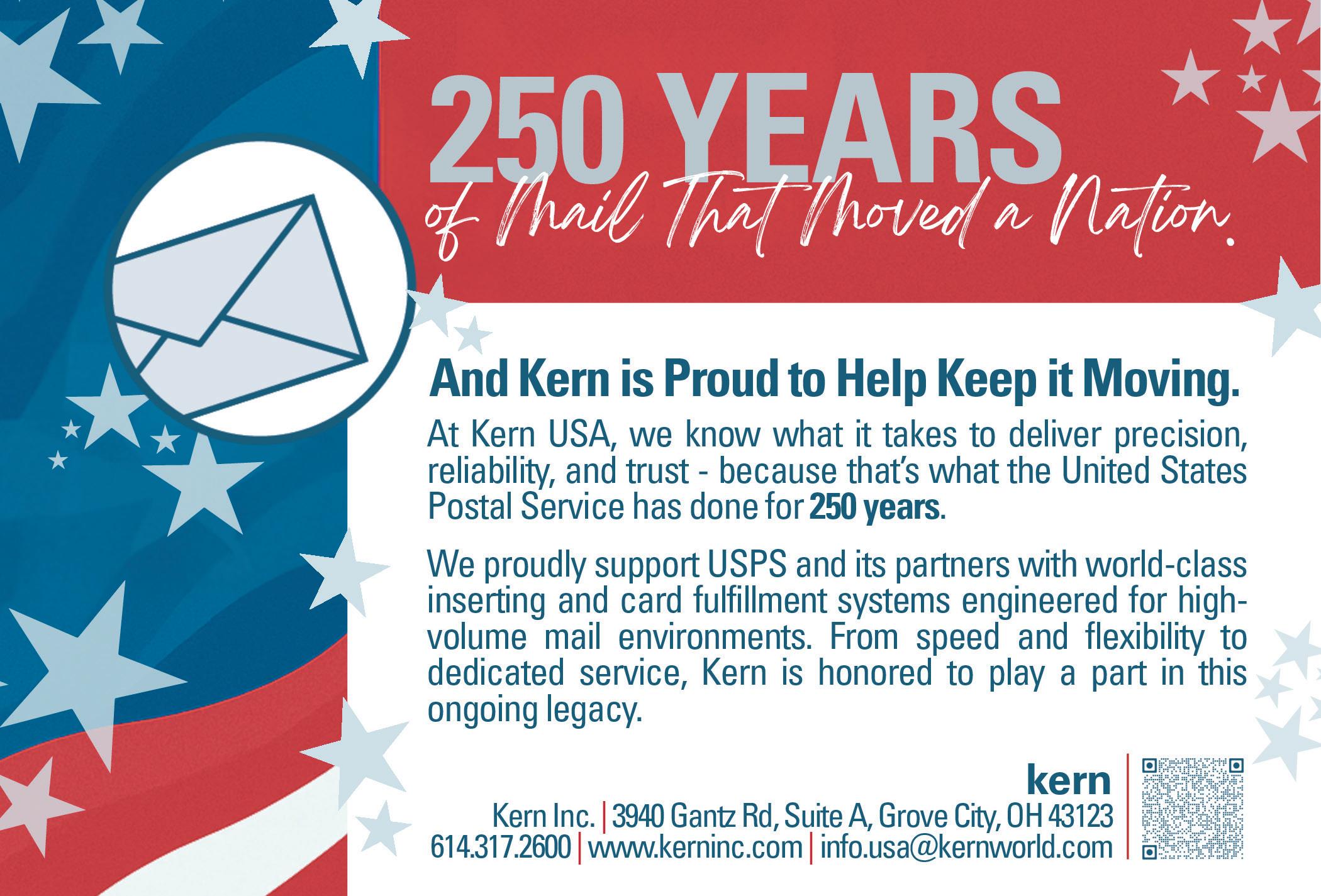

By Kathleen J. Siviter
marks the 250th anniversary of the Postal Service. In a sea of articles about the history of America’s Postal Service, I’m going to take a different slant and focus on how the Postal Service has been built over the decades through partnerships with the mailing industry. But first, some basic history of how the USPS came to be…
The origins of today’s United States Postal Service began in July 1775, when the Second Continental Congress declared that a Postmaster General be appointed to what was then the United Colonies, stating that the “conveyance of letters and intelligence were essential to the cause of liberty.” But it wasn’t until 1781 when Congress ratified the Articles of Confederation – Article IX –which added to the Constitution the exclusive right and power of the “Post” over mail delivery and post offices.
In 1828, the Postmaster General was made a Cabinet member position, and the Post Office was given a mail monopoly
and legislated to be self-funded. In the 1840s, postage was set based on weight and distance, with prepayment required, and the Private Express Statutes were established. The Post Office Department was established in 1872. In the 1860s, there was free city delivery of the mail by letter carriers and there were three products, with transportation awarded through contracts. In the 1890s, Rural Free Delivery (RFD) was introduced and transportation was expanded.
Now, I admit I’m skipping over many historical details of how the Postal Service came to be and how its formation and evolution recognize the value of mail delivery service in the US. I highly recommend reading more of the USPS’s history to fully understand how it evolved from its creation to present day — there are some fascinating changes that took place over the 250 years. But let’s take a look at how industry partnerships became the cornerstone of supporting and growing the postal system.

As America grew and prospered, so did the mail. From the late 1800s through the 1960s, the use of mail by Americans and American businesses grew exponentially. The development of computers and the introduction of credit cards generated increasing volumes of First-Class Mail, and businesses increased their use of mailed advertisements and magazines. In the earliest days of catalogs — which began as far back as 1845 with the Tiffany & Co. “Blue Book” catalog — catalogs were largely delivered by private carriers because the Post was too expensive. In 1863, “third class” advertising mail was created, and in 1872, the first Montgomery Ward catalog was mailed. From 1890 to 1930, third-class mail volume soared.
By the early 1960s, however, the Post Office Department was struggling to handle what then-Postmaster General Fred Belen called “mountains of mail.” It was during this time that the Post Office Department enlisted the burgeoning mailing industry to help it improve efficiency and service and lower its costs.
Zone codes, which were used in the 1940s during World War II, were expanded to 5-digit ZIP Codes in the 1960s with the introduction of Mr. Zip. The Post Office Department introduced in 1961 the Nationwide Improved Mail Service program (NIMS), which initially focused on having mail brought in earlier in the day so the Post had longer processing times. The Post subsequently asked mailers to help market and adopt the ZIP Code, and then to more finely sort their mail — at first there was no financial benefit offered, but mailers were interested in improving service, so they assisted.
In the mid-60s, the Post Office Department introduced new communication channels with business mailers to strengthen the collaboration, with the Mailers Technical Advisory Committee (MTAC) introduced in 1965 and Postal Customer Councils (PCCs) introduced soon after, and the first National Postal Forum held in 1967.
In 1971, the Postal Reorganization Act (PRA) was passed by Congress, transforming the Post Office Department to the United States Postal Service — a self-supporting establishment of the US government with more authority over its own operations. From the 1970s to the 2000s, mail volumes continued to grow, and the USPS’s delivery network also grew, with about 80% of its costs tied to labor. According to studies, the USPS was able to deliver 145% more mail in 2000 than in 1970 with only 22% more employees, largely due to automation and the help of the mailing industry.
Over the decades since then, the USPS-industry partnership and use of what has been called “workshare” (a public-private partnership model) continued to grow. The first workshare discount was introduced in 1976 (a one-cent discount for presorting First-Class Mail by ZIP Code), with additional discounts introduced for different types of sortation in the years following. According to a report by the USPS Office of Inspector General, workshare in 1999 alone saved the USPS $15.3 billion — nearly one quarter of its operating costs. Workshare grew to include use of nine-digit barcodes, then 11-digit barcodes, and, later, the Intelligent Mail barcode.
In the 1990s, the USPS, at the behest of the mailing industry, introduced the first transportation workshare discounts with “drop ship.” Throughout the history of the Postal Service, it has used private contractors to assist with its transportation needs — from horses to coaches to boats, trains, planes, and trucks. Today, nearly 90% of all Marketing Mail is drop ship entered (transported) by the mailing industry closer to its destination in the USPS’s network. Working collaboratively with the USPS, the mailing industry
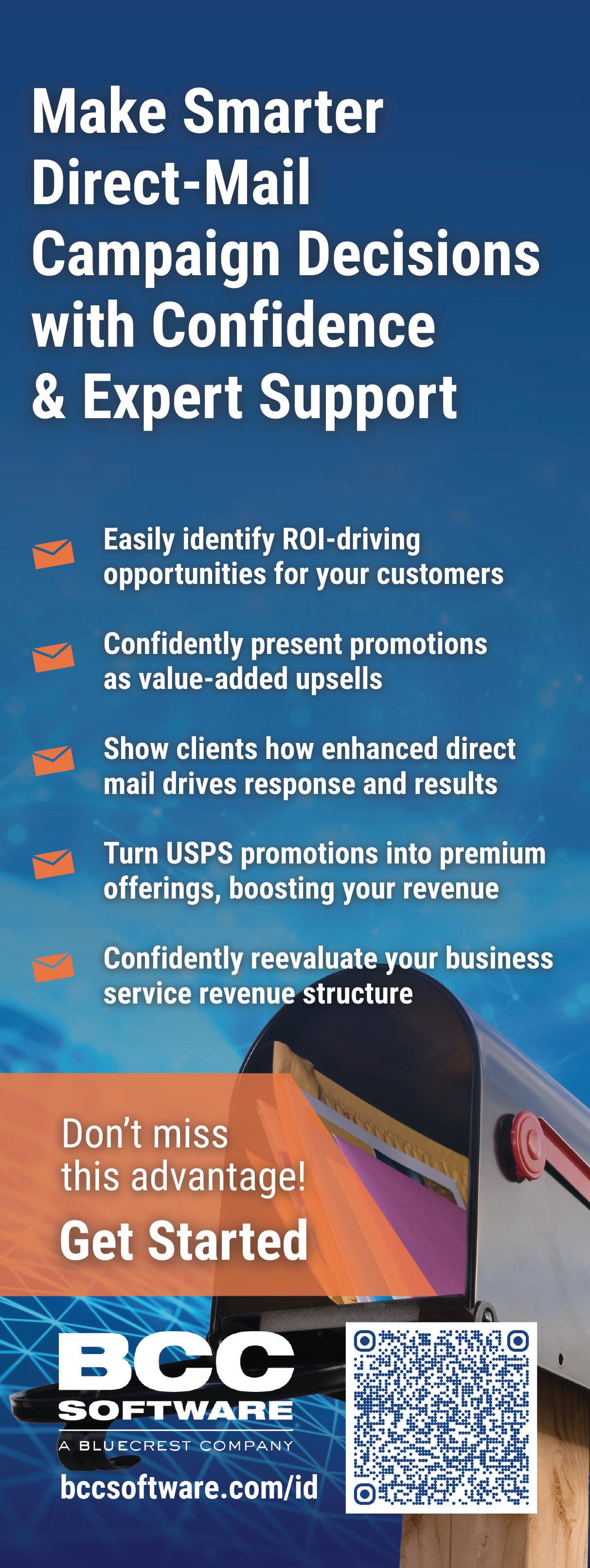
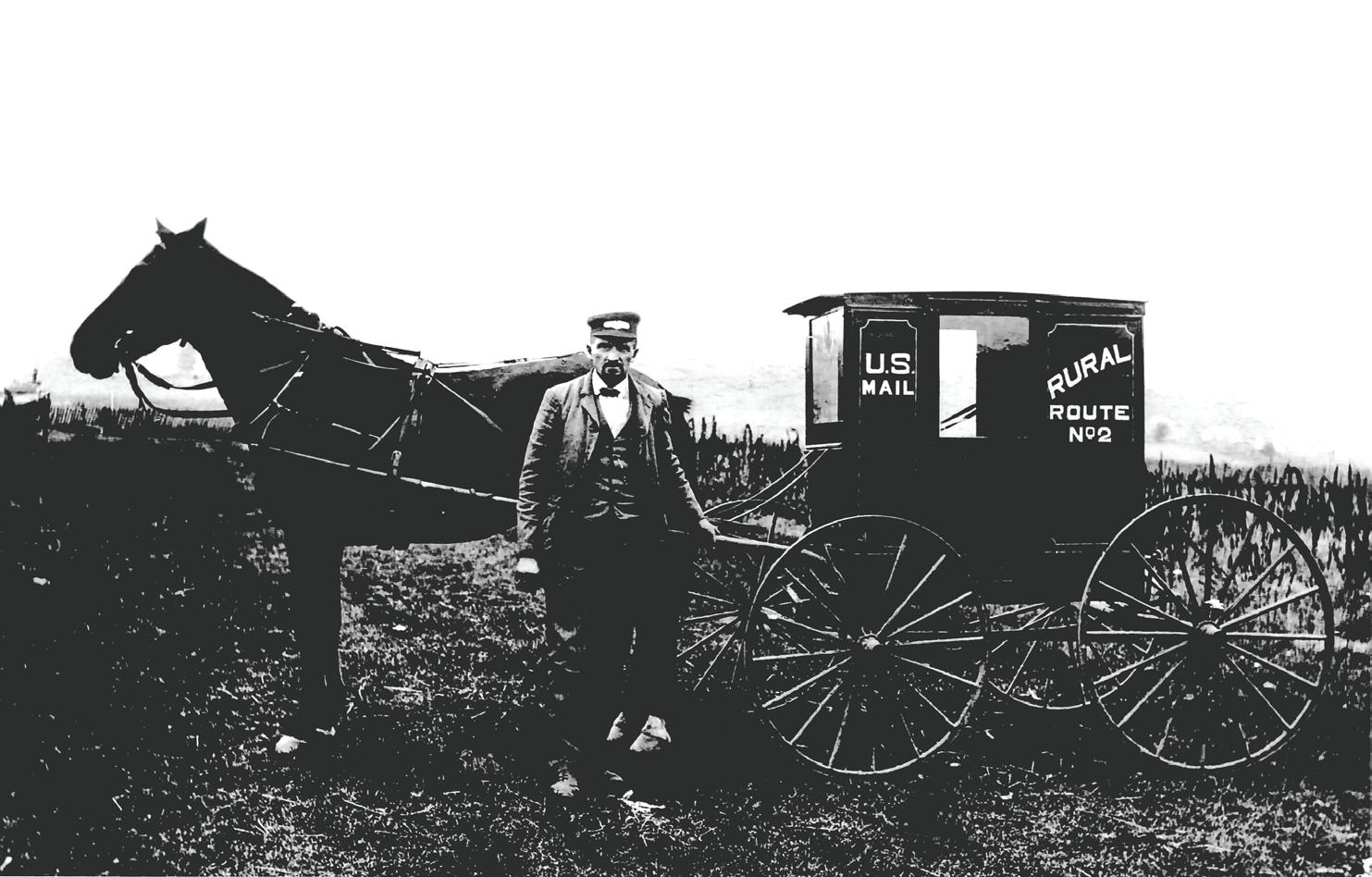
helped bring a flurry of new technologies and programs to the drop ship process, including FAST, eInduction, and a host of scanning and visibility technologies.
Working collaboratively over the years, the USPS and industry have tackled significant issues such as poor address quality, introducing solutions such as ACS, NCOA, FastForward, and later Move Update. Postage payment and mail entry are other areas where the USPS and industry have worked together to develop and implement mutually beneficial systems and processes. Mail tracking and service performance monitoring are other valuable improvements that have resulted from continued collaboration between the USPS and its industry partners.
This history lesson is a clear one – the USPS of today would not exist without the strong collaboration and support from the mailing industry.
From 2007 through 2020, hard times hit the USPS and mailing industry, from the Great Recession and its years of economic impacts to the pandemic and its devastating impacts on businesses. Mail volumes fell over 40% during this period, with some predicting that another 30% of volume will disappear in the next 10 years. When mail volumes began to fall, the USPS then began to work with the mailing industry to introduce innovations to stimulate use of the mail and response rates, ranging from repositionable sticky notes on mail pieces, Customized Market Mail, Every Door Direct Mail, and many more innovative ideas. Promotions and growth incentives were introduced and grew as a result of the USPS and industry working together to develop techniques to encourage use of mail.
Don’t Overlook the Packages
And let’s not forget the shipping side of the USPS’s business, where Parcel Post was first introduced in 1913. Before that time, six private delivery companies delivered most of America’s packages, with each serving a different geography. Once the USPS was allowed to carry packages, the volumes grew and grew, particularly when fueled by the growth in e-commerce and during the pandemic. The package delivery market has always been rife with competition, and in the 2007 Postal Accountability and Enhancement Act (PAEA), the USPS structure was changed so it could operate the parcels side of its business as Competitive Services under different regulations with fewer constraints than are in place for the market dominant mail side of the business.
Just as with the mail side of the USPS’s business, its competitive shipping side has grown through industry collaboration. As the USPS introduced more parcel products and services, an industry of intermediaries grew as well. Providers who offered easier access and use of USPS parcel products, as well as competitive rates and better customer support systems have flourished and helped the USPS significantly grow its parcel business over the years. As the USPS struggled with improving its parcel customer experience, tracking services, and payment technologies, industry partners worked with the USPS through venues such as MTAC to make recommendations around customer needs.
Everywhere you look in today’s huge and complex mailing supply chain, you see examples of the work the USPS and mailing industry have done together — tracking programs such as ADVANCE, CONFIRM, Informed Visibility; postage payment programs such as EPS (Electronic Payment System); programs to speed and improve accuracy of mail acceptance/verification such as MERLIN and Seamless Acceptance; and drop ship systems such as DSAS and FAST.
This history lesson is a clear one — the USPS of today would not exist without the strong collaboration and support from the mailing industry. From its humble beginnings in the 1880s, when the first “mail service providers” emerged, to 2023 when the mailing industry represented 7.9 million jobs and $1.9 trillion in sales revenue in the U.S. (EMA Foundation 2023 Mailing Industry Economic Job Study), the industry has worked in close partnership with the Postal Service.
If you want to learn more about the mailing industry and how it helped build today’s Postal Service, next time you are in Washington, DC, if you have not already visited the Smithsonian Postal Museum, I highly recommend it — particularly the exhibit on the mailing industry!
Kathleen J. Siviter is Asst. Executive Director of the National Association of Presort Mailers (NAPM) as well President of Postal Consulting Services Inc. (PCSi), and she has over 30 years’ experience in the postal industry. She has worked for the U.S. Postal Service, Association for Postal Commerce (PostCom), and others, as well as providing consulting services to a diverse set of clients with interest in the postal industry. She has also worked with PostalVision 2020, an initiative designed to engage stakeholders in discussions about the future of the American postal system.

with your biggest mailing, data quality, and print concerns. Not in the market for software right now? No problem. Connect with us to see if we can help with any future needs or enjoy our in-booth events and grab some cool Anchor swag. See you there!
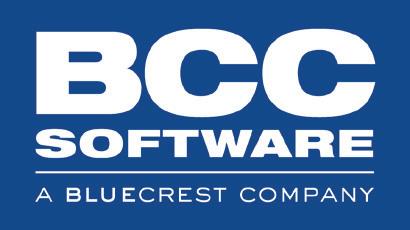
Better software equals better results. With over four decades of postal and address quality expertise, BCC Software’s products
Ignite, that allow mail processing in an automated workflow, to cloud-based solutions and APIs like BCC Architect. All our products and services are supported by experienced industry professionals. Contact us at bccsoftware.com.


and efficient while ensuring smooth operations and stronger performance without overhauling their entire infrastructure. eii-online.com |

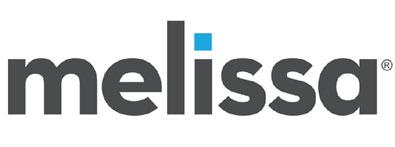
For 40 years Melissa has provided customer data lists, postal presort, data hygiene, and data enrichment solutions to optimize your mailings and mailing operations. We have just launched our newest product — a cloud-based customer management system (CMS) called the Melissa Alert Service. This one-of-a-kind list management platform provides a secure and scalable “vault” for your customers’ data while automatically notifying you of changes to the data including deduplication, change of address, address updates, property changes, deceased flagging, and events that matter to you. FTP and advanced API syncing is available. Pricing starts at just $95 per year for 10,000 records. Request a demo today. www.melissa-alert-service | info@melissa.com | 800.MELISSA

USPS raised rates on July 13, 2025 for the seventh time in four years (see Figure 1); mailers will be seeing some of the largest increases in history that are at a significantly higher pace than inflation. We can expect these rate spikes to continue as the USPS has stated that two increases per year will be their new norm.
We have been creating comparison charts that go over the changes in rates to show how they will affect budgets in order to provide a true comparison versus the overall average percentage increase that the Postal Service talks about. Based on the type of mail you send, the increase could be higher or lower. Also, when you look at the new rate charts provided by the USPS, they typically will not show the level of detail needed (previous and new rates, side by side) to see these differences.
Hopefully, this article will help you budget by seeing the impact of the most common services that you use today. At the bottom of this article, there is a link to an Excel tool where you can plug in your mail volumes to see the impact on your organization.
The price of a stamped First-Class Mail Single Piece letter and Metered letter are seeing a $.05 increase to $0.78 and
$0.74 (see Figure 2).
There is still a $.04 savings for metered mail, making it five percent less than a postage stamp. A single-piece flat is increasing from $1.50 - $1.63. The rate for additional ounces does not change in this rate change. The price
First-Class Mail Single Piece – 5% - 9% Increase
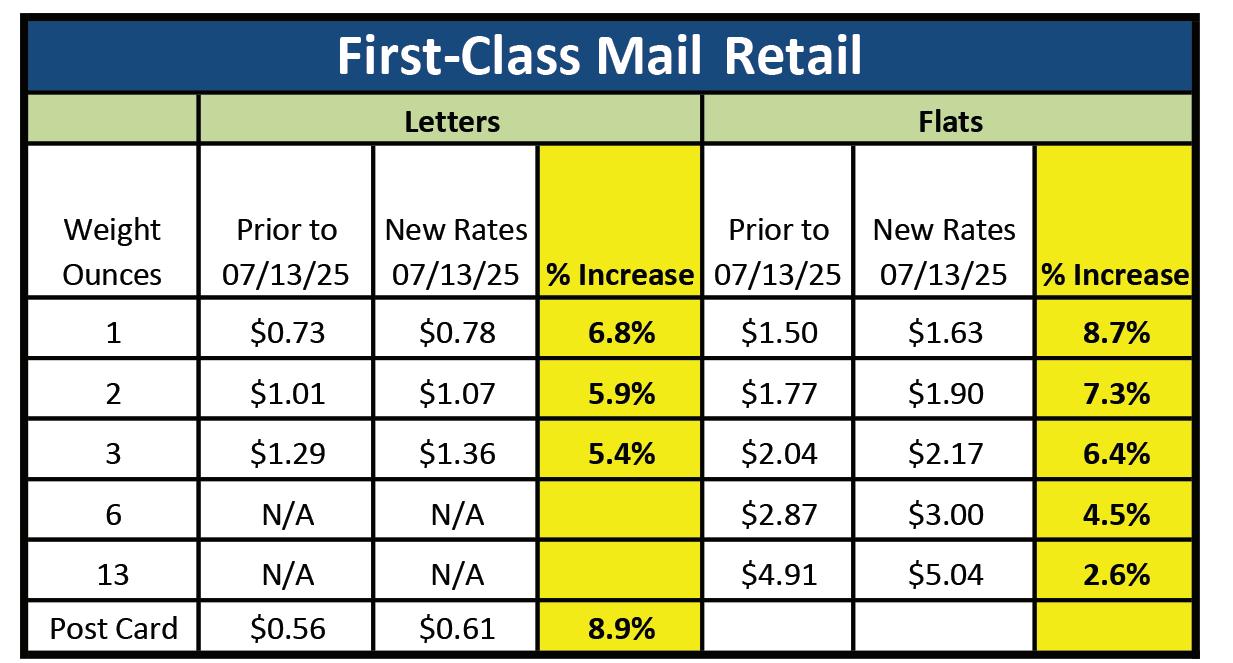
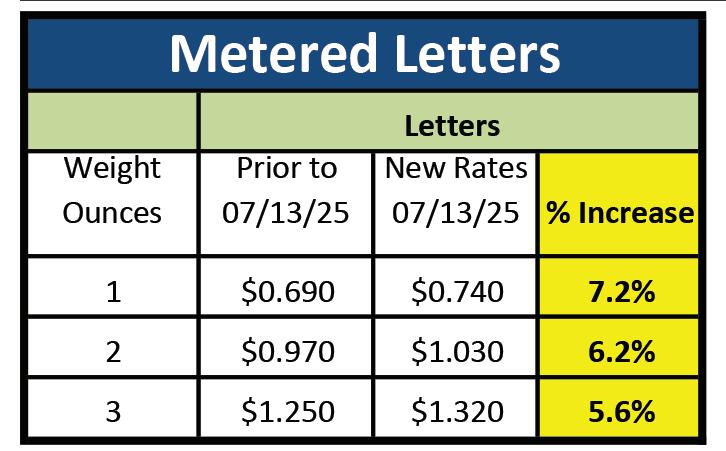
First-Class Mail Commercial – 8% - 11% Increase



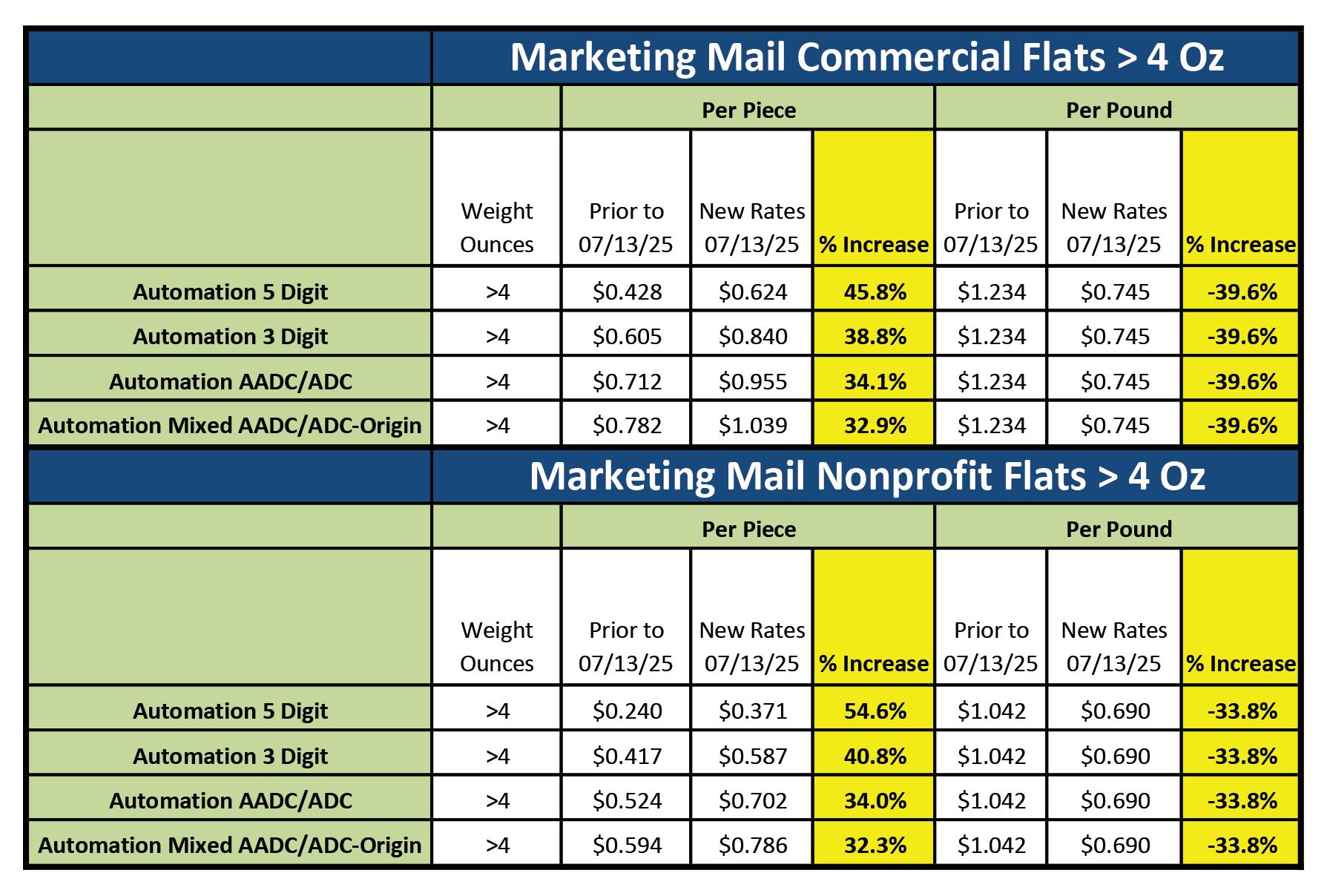
for postcards rose at the highest levels at nine percent.
Automation letters are going up eight to nine percent and Flats by nine to 11% (see Figure 3). There is still the same credit for Seamless Acceptance of $.002 and for Full Service Intelligent Mail at $.005. The biggest change is there is a new SCF Pallet Discount that saves $.004 for letters and $.002 for flats.
This is the first time this type of discount has been available for First-Class Mail; previously, it had only been an option for Marketing Mail. With any increase, it becomes more important to look for ways to reduce costs.
Figure 4 and the following list show some of the options available:
Use meters or online postage to save $.04 on letters.
Consider presort services if you run over 500 pieces per day or have one-time mailings over 1,000 pieces.
Automate your mailings in-house or through third-party mail services to have drastic postage savings.
Presort and automation levels go up to 3.5 ounces for the same base rate.

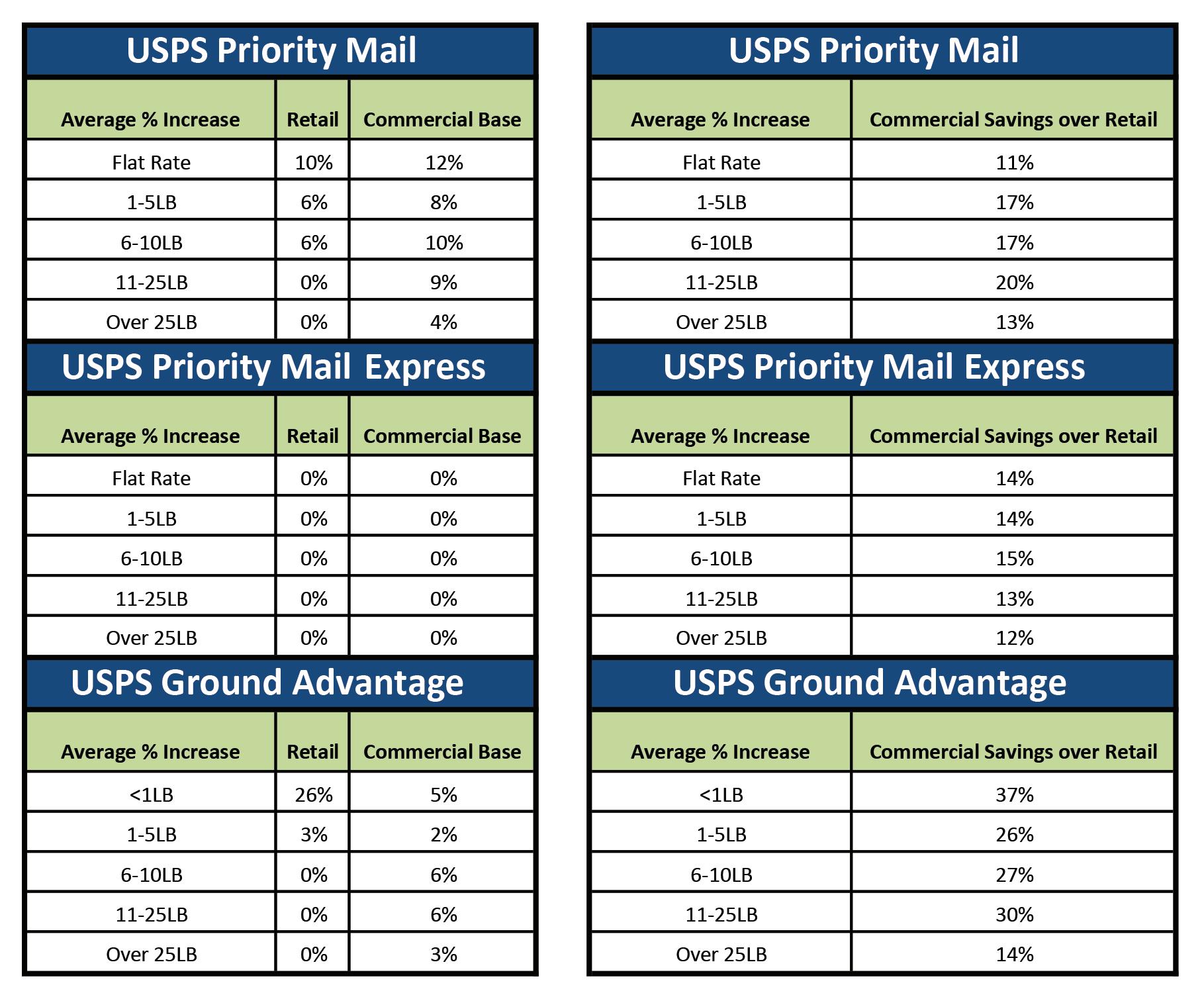
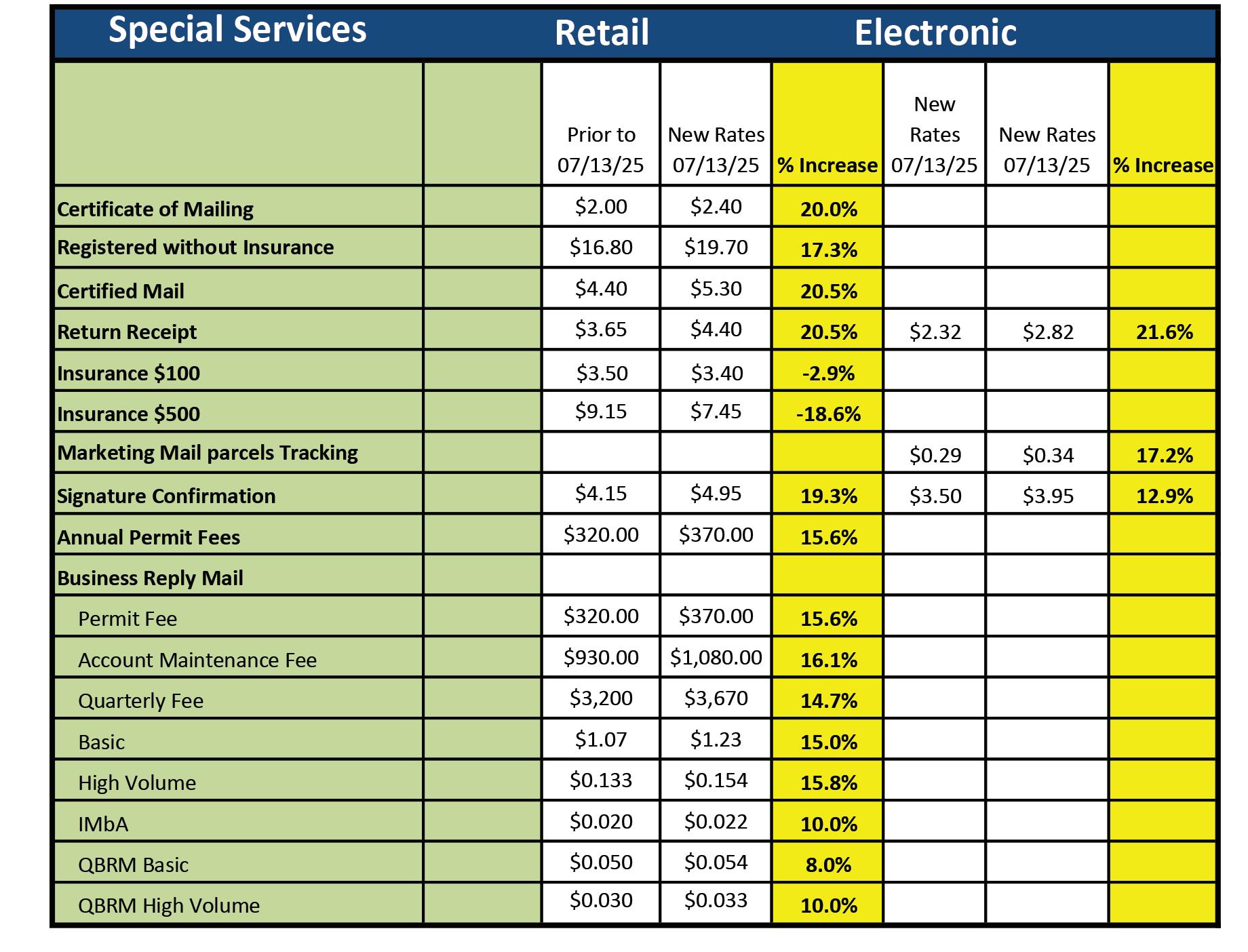
Flats and postcards can have the same automation rates as letters.
Consider moving generic content mail from First Class to Marketing Mail.
Marketing Mail Letter rates are increasing at approximately seven to eight percent, while Flats are going up at 12-14%. Nonprofit is seeing a smaller increase on letters at two to five percent, but similar with the flats at 12-14% (see Figure 5).
The biggest change is with heavy weight flats over four ounces. With these items, there is a per piece and per pound rate needed to calculate the total price. As you can see from Figure 6, the per piece rate is going up 32-54% and the per pound rate is going down by 34-40%. The net impact is that flats from five to seven ounces will see a four percent increase, while items over seven ounces will average an eight percent decrease.
The best way to save money on Marketing Mail is to move mail closer to its final location utilizing destination entry level discounts (see Figure 7). This area is seeing the biggest changes. The DNDC (Destination Network Distribution Center) discount has been eliminated, and the DSCF (Destination Sectional Center Facility) savings have been decreased by 35-58%. There are still the $.003 SCF (Sectional Center Facility) Pallet, $.005 Full Service Intelligent Mail, and $.002 Seamless Acceptance discounts available.
In the past, we have only seen changes with the parcel segment on the January rate case, but we are now seeing changes this July. Priority Mail rates have gone up in the less than 10LB segment for Retail at six to 10% and across all weights for the Commercial segment at four to 12%. We are not seeing any changes in Priority Mail Express. Ground Advantage rates have gone up an incredible 26% in the less that 1LB Retail segment, whereas Commercial rates are seeing a two to six percent increase across all weight segments.

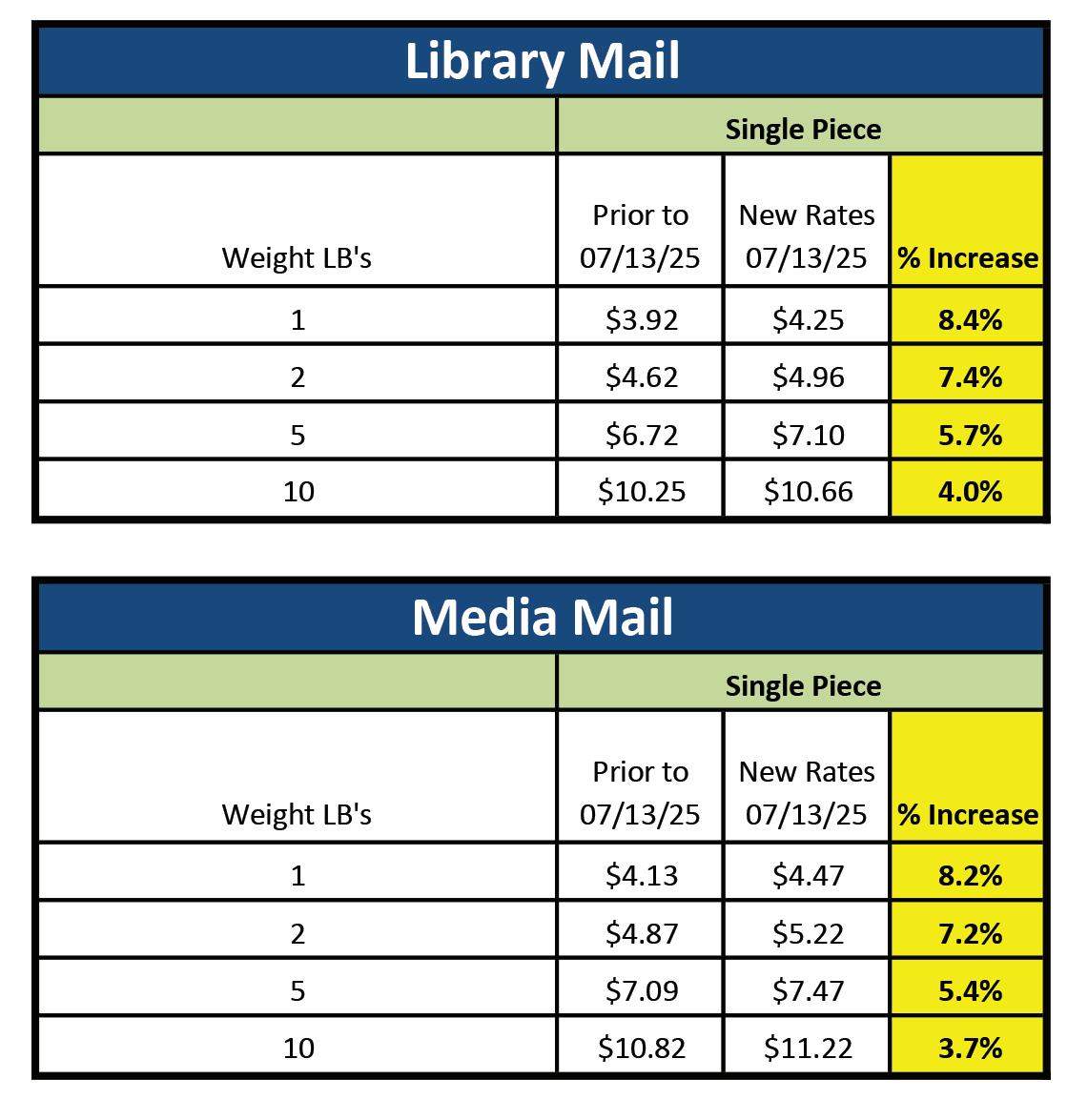
We encourage all entities to move to Commercial rates by using simple software utilities that can generate 4x6 shipping labels vs. processing these items through a postage meter or at the retail counter of the post office. As you can see in Figure 8, the savings are between 11-37% and some vendors will offer discounted cubic rate structures that save up to 89%.
Special Services are seeing their largest rate hike in years, averaging over 13% (see Figure 9). The most common special service is Certified with Return Receipts, where the overall increase of 21%. One bright spot is that the cost of USPS Insurance went down.
Conclusion
Increases of 35-74% in four years are unheard of and impacting every organization. Mailers are going to need to look for savings strategies to help offset these changes. Our recommendation is to create visibility to all mailings and look for automation and commercial methods where applicable to reduce the cost and streamline production.
To budget for this increase, you need to look at the type of items you are sending, and the weight and zones that are most common, to truly estimate the impact. We have developed a budget calculator that you can download for free (https://postaladvocate.com/rate-change-tools/) that should help you better plan for this year. Some of the most popular USPS classes are going up at the highest rates but luckily there are ways to help mitigate this through automation and technology.
Adam Lewenberg, CMDSS, MDC, President/CEO of Postal Advocate Inc., runs the largest Mail Audit and Recovery firm in the United States and Canada. They manage the biggest mail equipment, postage, and mail-related services portfolio in the world. Their mission is to help organizations with multi-locations and mail streams reduce expenses, recover lost postage funds, and simplify visibility and oversight. Since 2011, they have helped their clients save an average of 74% and over $94 million on equipment, postage, shipping, and outsourced mail service fees. He can be reached at 617.372.6853 or adam. lewenberg@postaladvocate.com. If you are interested in accessing any of these charts online, visit https://postaladvocate.com/rate-change-tools/.
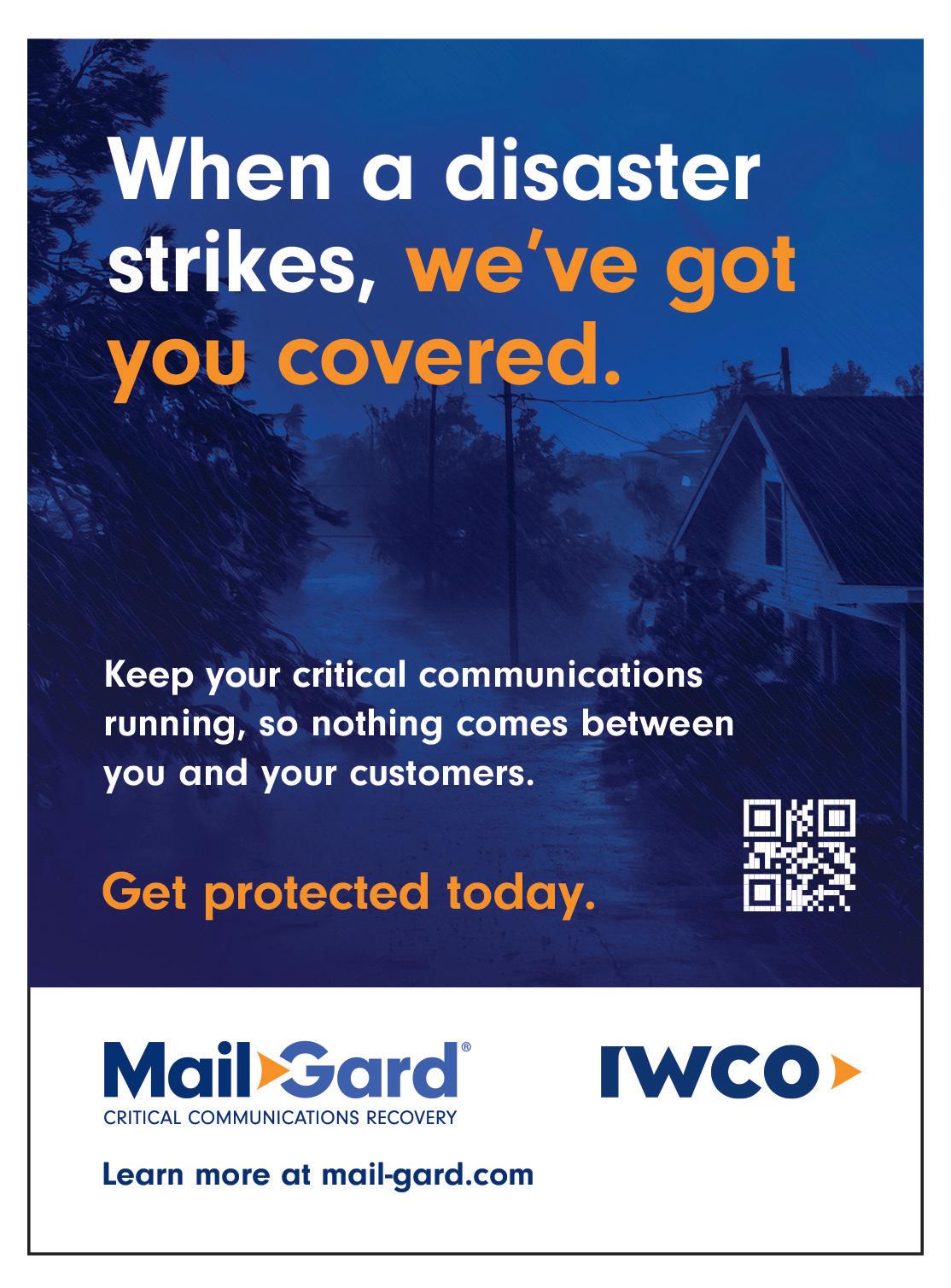

Extended Producer Responsibility (EPR) is an environmental policy approach that intends to hold brand owners, licensees, importers, and distributors accountable for the entire lifecycle of their products, especially the take-back, recycling, and final disposal. This strategy aims to incentivize producers to design environmentally friendly products by making them responsible for the costs associated with the end-of-life management of their products.
Several US states have enacted EPR laws targeting packaging or packaging and printed paper materials. As of April 2025, states including Washington, Maine, Oregon, California, Colorado, and Minnesota have passed such legislation, with a Maryland bill the latest to be signed into law, and two bills under consideration in New York. These laws vary in scope and implementation timelines, but they collectively signify a shift towards producer accountability in waste management.
Oregon’s Recycling Modernization Act (SB 582B), enacted in 2022, is a pioneering Extended Producer Responsibility law that mandates producers of “covered products” — including packaging, food serviceware, printing and writing paper, newspapers, magazines, catalogs, telephone directories, and similar publications — to participate in a producer responsibility program. By July 1, companies that are considered producers must:
Register with and be a member of a Producer Responsibility Organization (PRO) that administers a state-approved producer responsibility program.
Pay an annual membership fee to its PRO. The PRO will set fee schedules each year. Fees will be based on the quantity and type of each covered product, environmental considerations, and the impacts of each material type on the PRO’s cost obligations.
Upon request, provide the PRO with records or other information necessary for the organization to meet its obligations.
The Circular Action Alliance (CAA) has been designated as the PRO to administer Colorado, Minnesota, California, and Oregon’s EPR programs. Oregon’s law is similar to others being enacted and may have a far-reaching chill in the paper industry. After Maryland Gov. Wes Moore signed that state’s EPR into law, the AF&PA weighed in on the decision: “This costly approach to EPR ignores the complexities of the state’s recycling system and the paper industry’s significant recycling achievements. The legislation also imposes fees on ‘paper products,’ like unprinted copy paper, which do not typically end up in recycling bins. As a member of the EPR Advisory Council, AF&PA looks forward to promoting practical, evidence-based implementation strategies to mitigate harm to Maryland’s recycling efforts.”
“Each law typically requires producers to initially register with the state and/ or PRO by a given date,” according to a recent Covington compliance alert. “Each law then generally imposes a final compliance deadline upon which a producer may not sell covered products in or into the state unless that producer belongs to a PRO. Joining a PRO means that producers typically have obligations to report relevant data and pay fees to the PRO. There may be other requirements as well, such as meeting reduction targets or engaging community stakeholders.”
Fee structures are provided, and penalties for noncompliance with the EPR vary by state. Fees for paper recycling are comparatively low relative to metals, ceramics, and other materials, with the exception of coated paper, which could cost up to .43/lb to recycle. In addition to costs, the paper and printing industry, which already boasts high recycling rates, faces other challenges under EPR laws, such as operational adjustments and administrative burden to stay compliant with EPR requirements.
AF&PA points out that the proposed EPR legislation in New York ignores the complexities of the state’s recycling system and the paper industry’s supply chain, and insufficient data is available to move forward with new programs. EPR programs, according to AF&PA, often treat highly recycled materials, such as paper, the same as hard-to-recycle materials. This can result in highly recycled materials subsidizing the cost of collection and recycling for materials with low recycling rates, with costs being passed on to consumers and taxpayers, ultimately.
While EPR laws aim to enhance environmental sustainability, it’s crucial for policymakers to consider the existing recycling efficiencies within the paper and printing industry. Collaborative efforts between industry stakeholders and regulatory bodies are crucial for developing EPR frameworks that acknowledge the industry’s contributions to recycling and ensure that new regulations do not inadvertently hinder its progress.
Two Sides North America aims to educate all types of consumers on the sustainability of paper, print, and paper-based packaging. Visit twosidesna.org for more information.

